Somehow I agreed quite quickly with my friends, Irena and her husband Igor, that I could join them at some hiking trip. Namely, in the last couple of years, the two of them have been going hiking rather frequently and every time Irena told me about it, it all sounded very nice and attractive, so we agreed that all three of us should go for a weekend in Vrdnik with an intention to walk around Fruška Gora mountain.
The agreement was that we should go at the beginning of August and we delegated our respective tasks right away: Irena was in charge of the booking of the accommodation, Igor of the planning the hiking routes and I was in charge of the transportation. I also asked them to do me a favour and that we go and visit the monuments of culture that were on our way. Although the two of them prefer nature, they did not object and granted me the wish, so I also prepared the basic information about the monuments of culture located in Vrdnik and its surroundings. Namely, the plan was for us to stay in the village itself and to visit the monuments either on foot or by car.
Vrdnik is a village situated on the south slope of Fruška gora and this name was first mentioned back in 1315 as the Vrdnik fortress, but then there was a long historic break and the name started to be mentioned again only from 1702, this time as a settlement. At the beginning of the 19th century, a brown coal mine was opened here, but it was closed in 1968. There are also sources of thermal and mineral water, which led to the development of tourism in Vrdnik, since in addition to the walks and sightseeing in the surroundings, as well as recreational enjoying of the numerous swimming pools, there is also a proper spa here that is suitable for the treatment of rheumatoid ailments, postoperative conditions, etc.
We settled at a suite that was a little outside of the centre, but this did not bother us in the least since we had a lovely view.
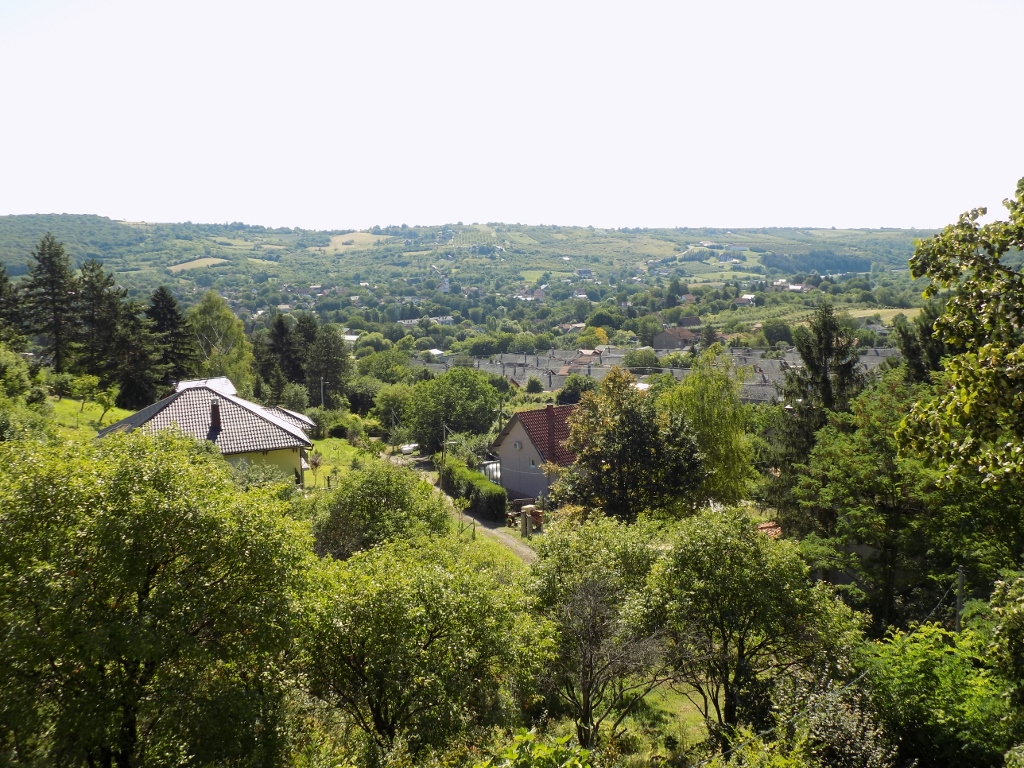 View from the suite at the centre of Vrdnik
View from the suite at the centre of Vrdnik
Having arrived at the suite and taking over the keys, we changed our footwear and got the necessary things, after which we headed on foot towards the centre of the village. Although it was just past 10 in the morning, it was already hot and thus walking along a longer street we were trying to find some kind of shade. At some point Igor noticed a very cute bunch of the common houseleek (Sempervivum tectorum) growing on a roof. The plant has been grown extensively throughout Europe ever since the ancient Romans and their belief that it protects houses against lightning strikes.
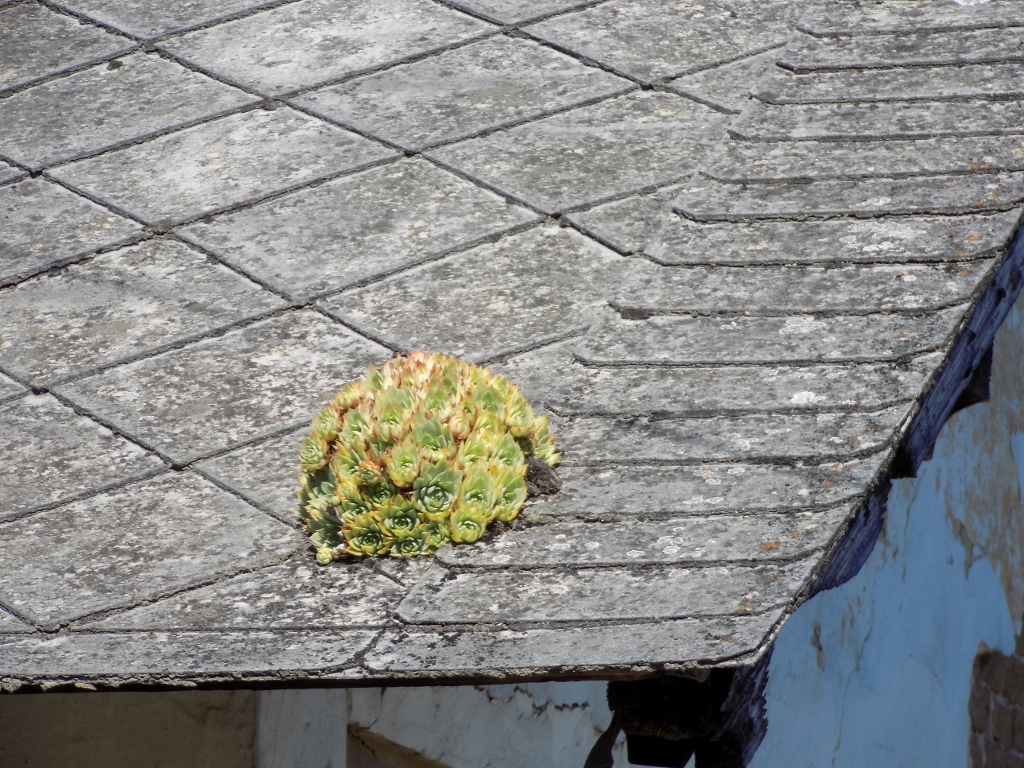 Common houseleeks and the roof of a completely protected house
Common houseleeks and the roof of a completely protected house
Soon we got to the first monument of culture from my list. This was the “Kasina” building. This is a building that was made in 1910 in the Art Deco style.
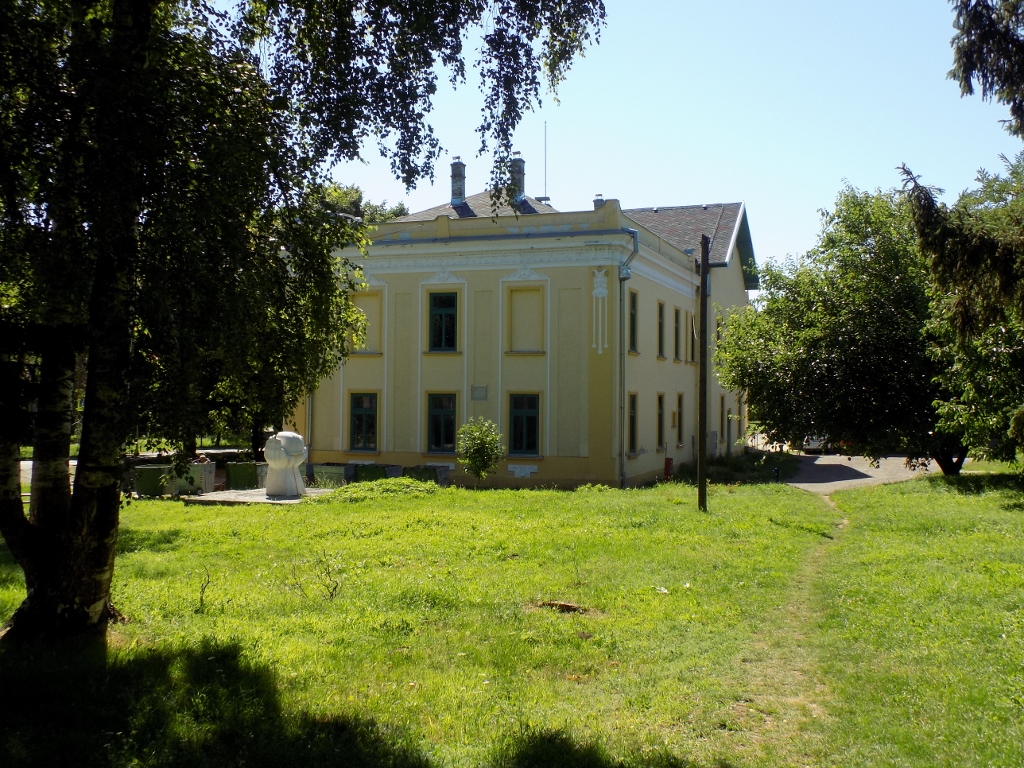 Approaching the “Kasina” building
Approaching the “Kasina” building
The building was originally used for the placement of the manager of the coal mine and his guests. Nowadays, however, there are offices of the local administration, as well as a library, and Irena also saw through a window some kind of a gym. Or perhaps the civil servants at the local community diligently do their physical exercises during lunch breaks? It needs to be said that the building cannot be seen completely from the front and thus the beauty of its facade cannot be fully appreciated on account of some trees, but even a view from the side suffices to conclude that this is a very nicely kept building.
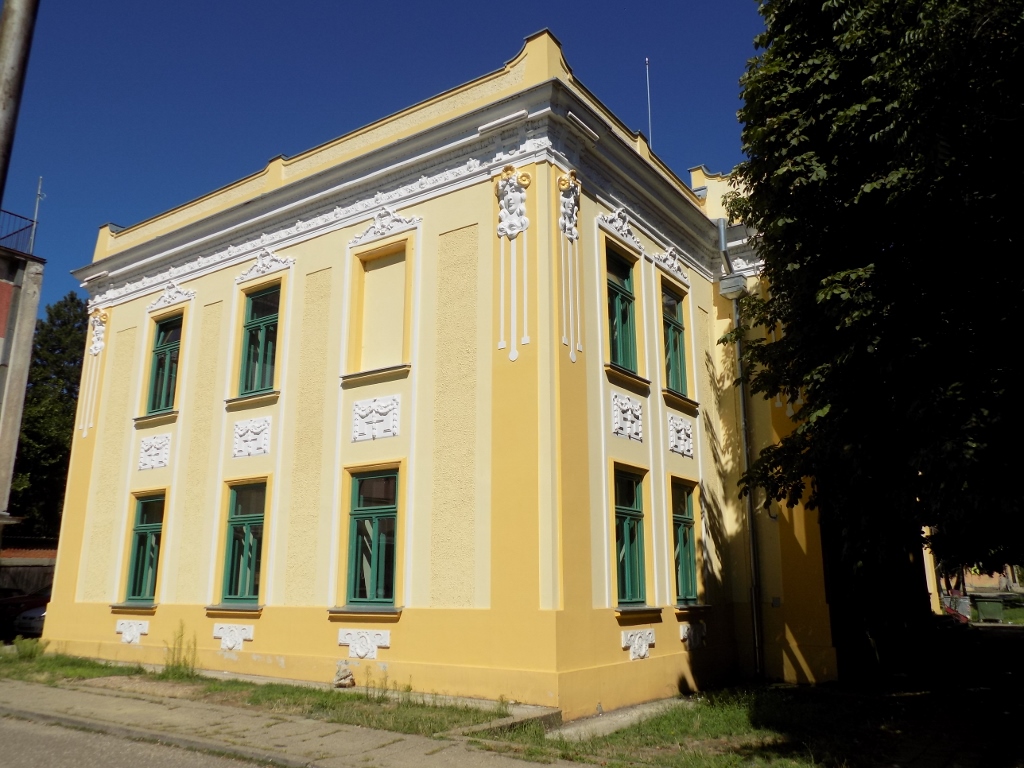 “Kasina” building, a side view
“Kasina” building, a side view
Then we went to the main crossroad in the village and further towards the nearby Vrdnik Monastery that is categorised as the monument of culture of exceptional importance and that is the only monastery among the numerous monasteries of Fruška gora that is situated within a human settlement.
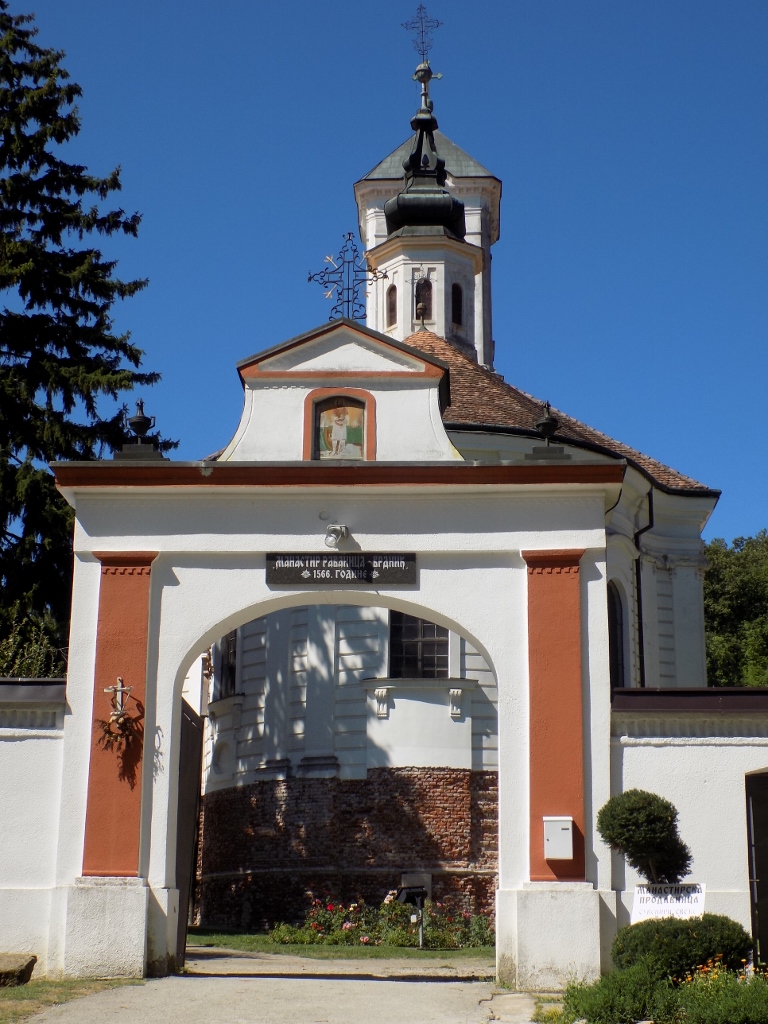 Approaching Vrdnik Monastery
Approaching Vrdnik Monastery
Vrdnik Monastery was built in the 16th century and it incorporates a church dedicated to the Ascension of Our Lord. The first church and the dormitories were made of undurable materials, on top of which the Austrians and the Ottomans kept replacing one another as the rulers of these areas. All of this impacted the history of the monastery that was abandoned by the monks from time to time, but then the new ones also came and so at the end of the 17th century the monks from Ravanica Monastery in central Serbia came here bringing parts of the treasury with them, including, as the most important piece, the relics of Prince Lazar. Since then, this monastery has often been called New or Small Ravanica. By the way, you can read about the proper Ravanica Monastery in my story at https://www.svudapodji.com/en/serbia-2006-1/.
When one enters the churchyard, on the right-hand side there is a monument to poetess Milica Stojadinović Srpkinja that was erected here in 1912.
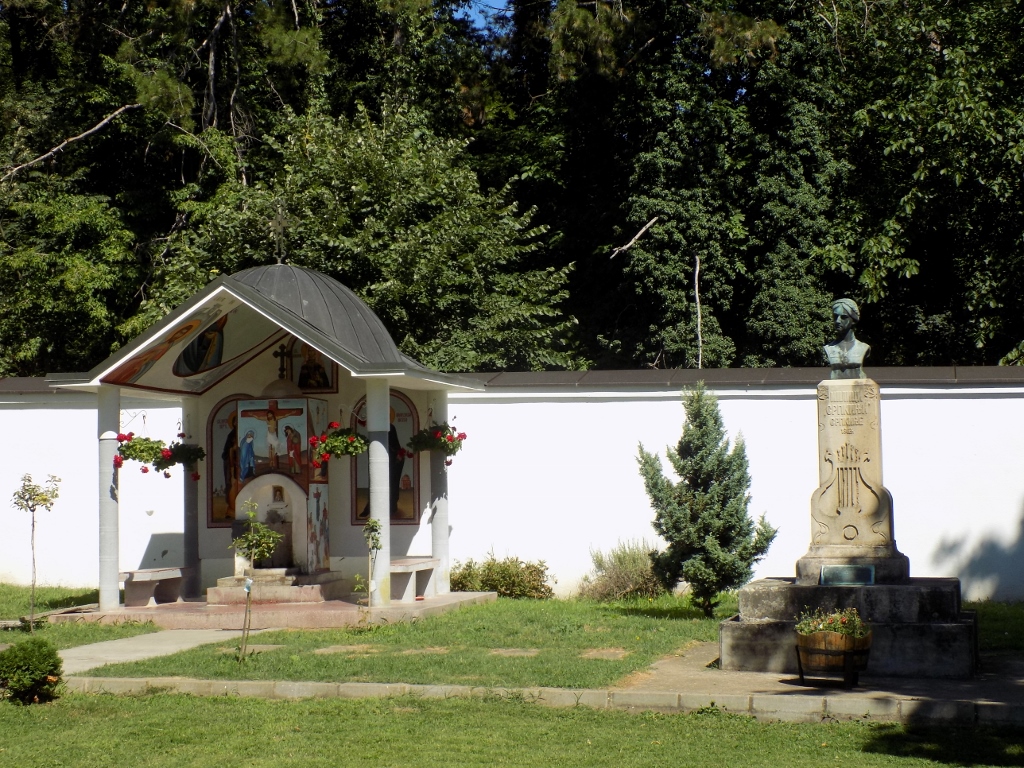 A part of Vrdnik Monastery’s churchyard, with the monument to Milica Stojadinović Srpkinja to the right
A part of Vrdnik Monastery’s churchyard, with the monument to Milica Stojadinović Srpkinja to the right
As for the church, a new, large church at Vrdnik Monastery was built at the beginning of the 19th century and it was consecrated in 1811. This is a single-nave building that has a comparatively small dome and a bell tower that rises above the narthex.
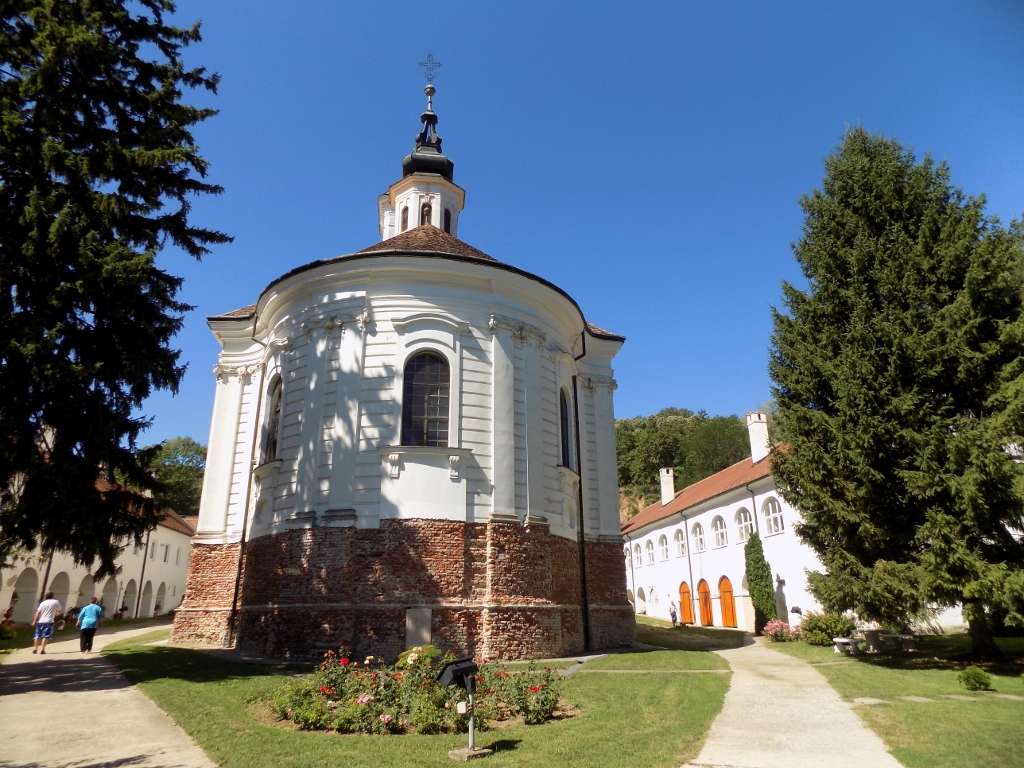 Church of the Ascension of Our Lord at Vrdnik Monastery
Church of the Ascension of Our Lord at Vrdnik Monastery
Both on the outside (up to the height of a few metres) and on the inside it could be seen that there were ongoing restoration works at the church, both concerning the architectural elements and the painting ones. Still, when one enters the church, the gaze is naturally first drawn towards the altar and the opulently made iconostasis.
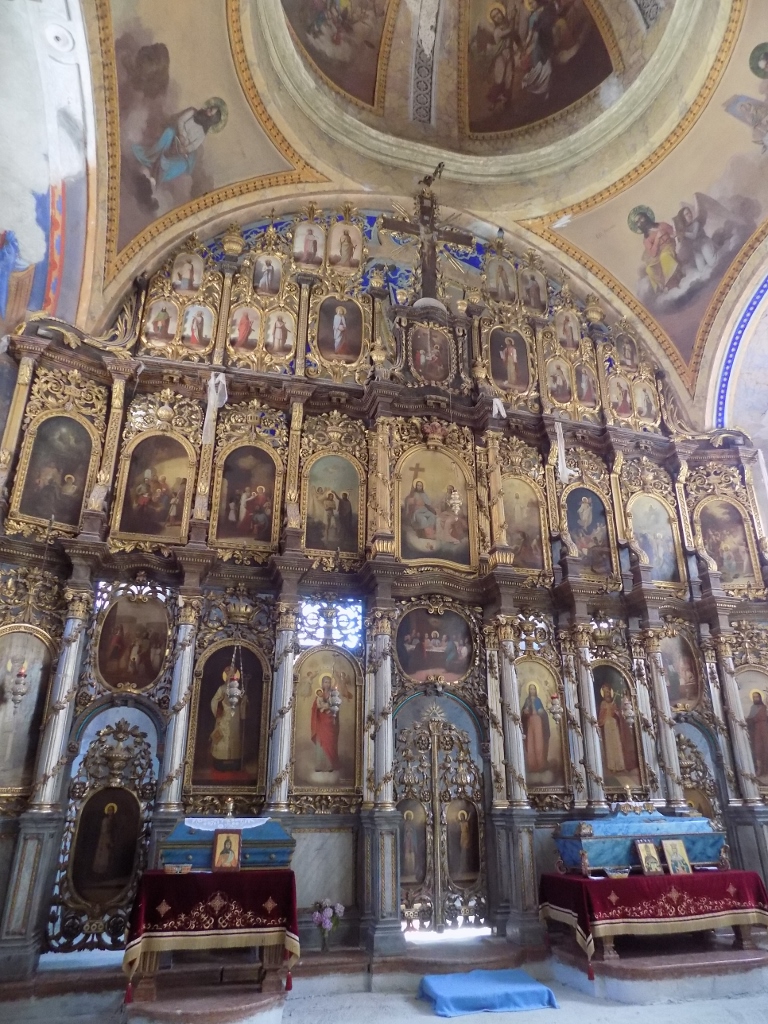 Iconostasis of the Church of the Ascension of Our Lord
Iconostasis of the Church of the Ascension of Our Lord
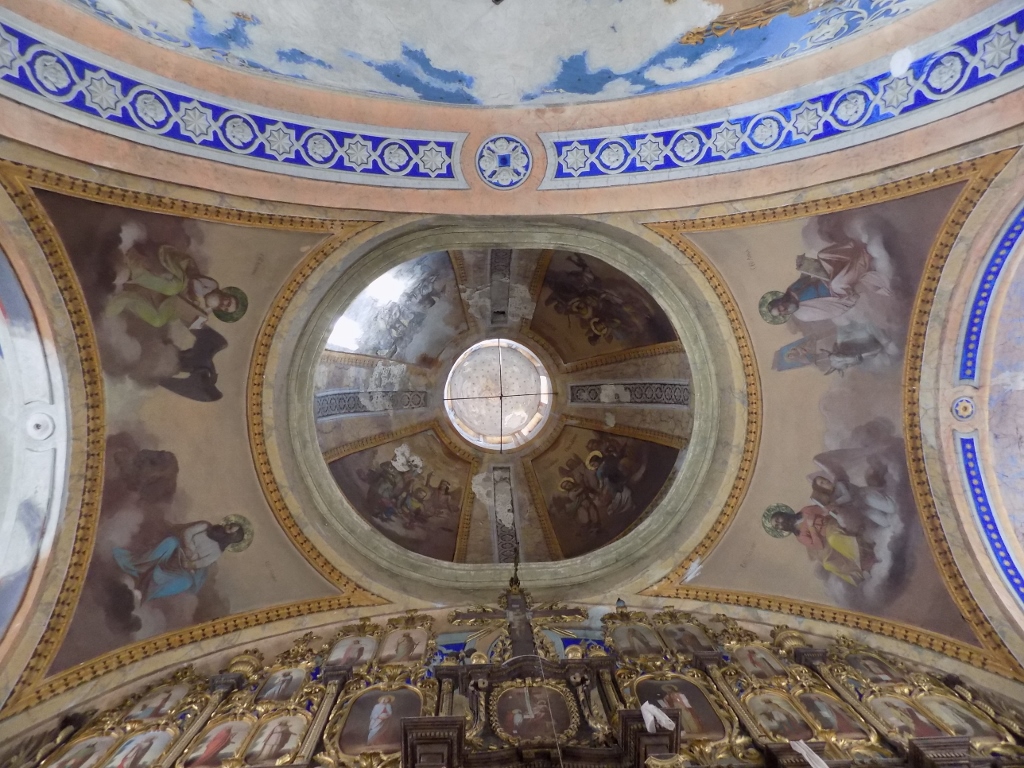 View at the interior part of the dome rising above the front side of the altar partition
View at the interior part of the dome rising above the front side of the altar partition
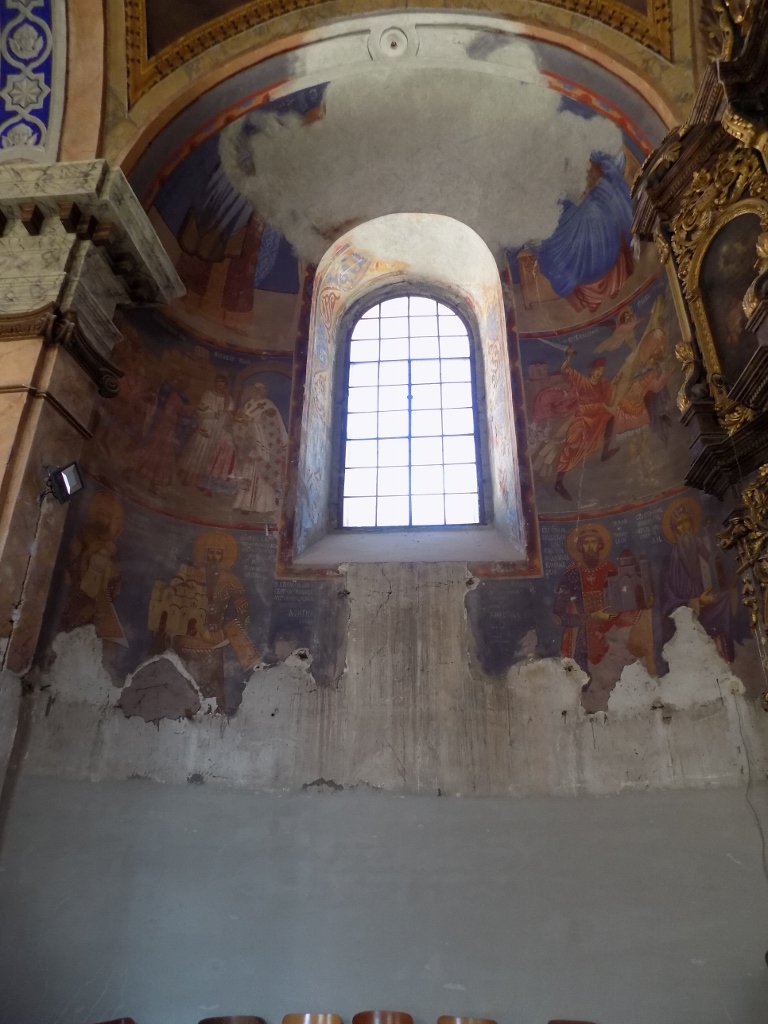 Remains of the frescoes and the works on their restoration
Remains of the frescoes and the works on their restoration
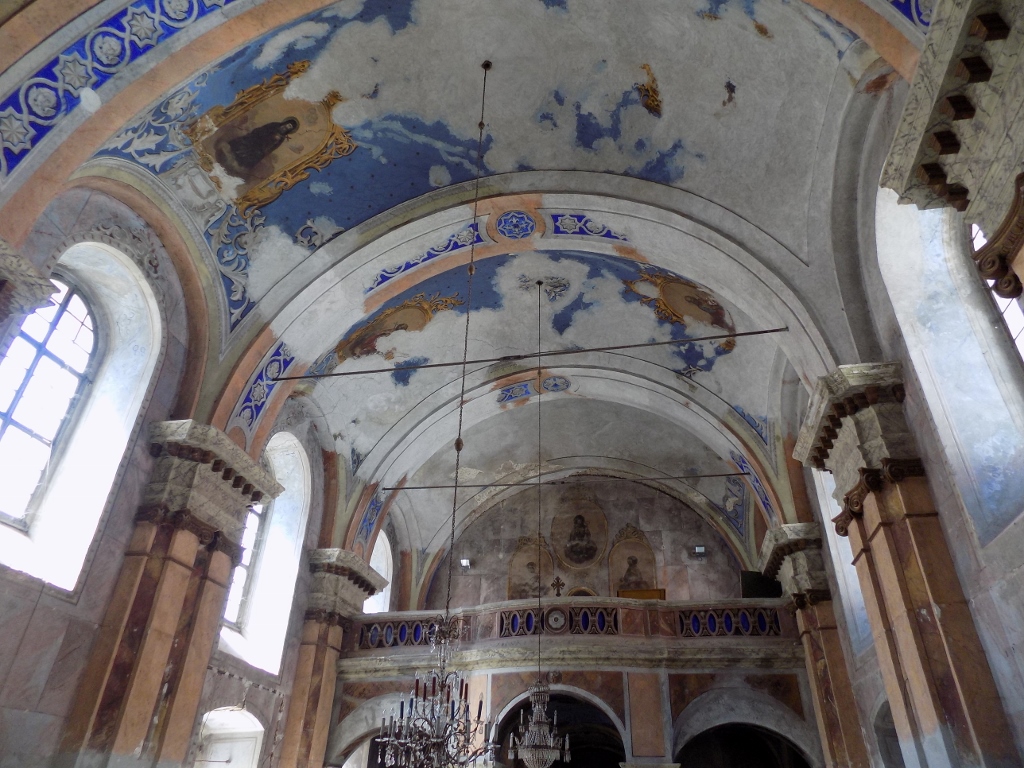 View at the part of the church above the narthex
View at the part of the church above the narthex
As for the relics of Prince Lazar, i.e., Saint Lazar, a decision was made around the middle of the 20th century to return his relics back to Ravanica Monastery and this was done in 1989 when the 600th anniversary of the Battle of Kosovo was celebrated. Prince Lazar was killed in this battle. A small piece of the relics was still left at Vrdnik Monastery where it has been kept ever since.
When we finished with the visit to the monastery we headed for the Tower of Vrdnik, a monument of culture of great importance. What was important for us at this point in time, however, was that we could walk there and that meant some hiking through nature. Still, in order not to walk along the main asphalt road all the time, which does run through the forest, we turned onto a macadam road first, then got to a smaller asphalt road, but there was practically no traffic there, so we did not mind. Mind you, what was very uncomfortable was the fact that there was no shade whatsoever and so all the time we walked in the scorching sun. Yes, that was rather exhausting, but at some point we got to the greenery and the forest, so we went uphill there and relatively soon we reached the very top of the elevation on which the tower is situated.
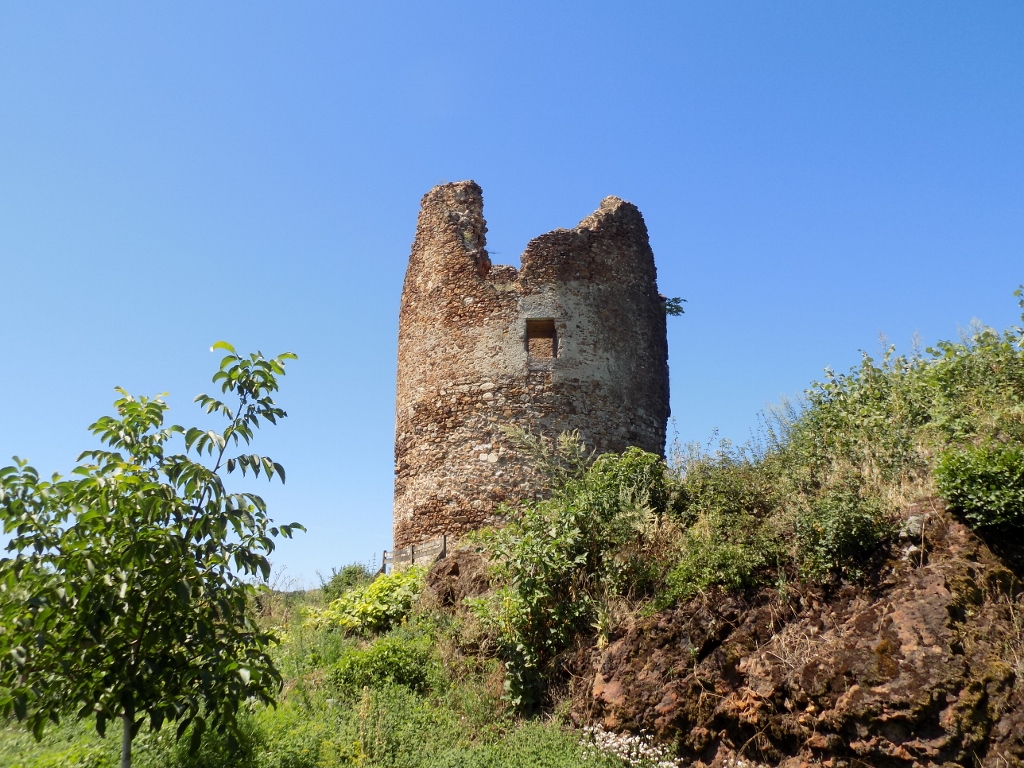 Tower of Vrdnik
Tower of Vrdnik
On top of an elevation that is located at around 400 m a.s.l., there are remains of the fortification of Vrdnik mentioned in the written sources for the first time in 1315. The dominant part of the fortification, which is also in the best shape, is precisely the main tower, although there are other remains of the fortifications as well.
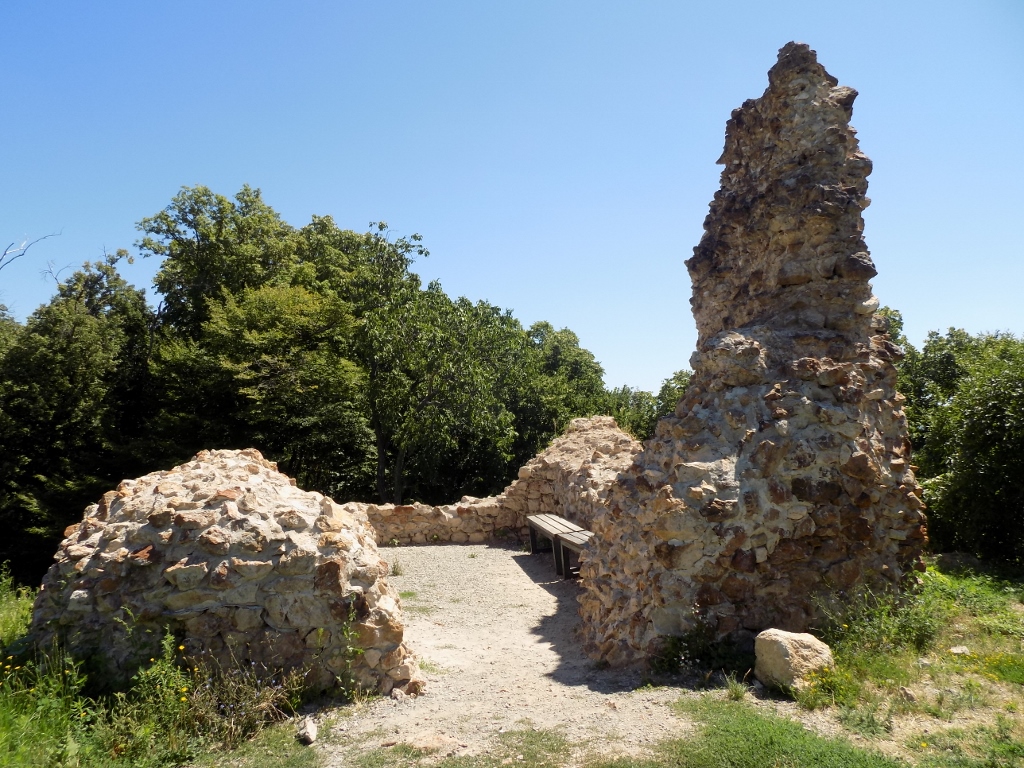 Ruins of the medieval fortification of Vrdnik
Ruins of the medieval fortification of Vrdnik
No comprehensive surveys have been conducted here and so there are no precise data concerning the fortification, but over time a stairway has been constructed so that visitors can climb up to the higher sections of the tower. The outside stairway leads to the first level, while within the tower there is another flight of stairs leading to a higher floor.
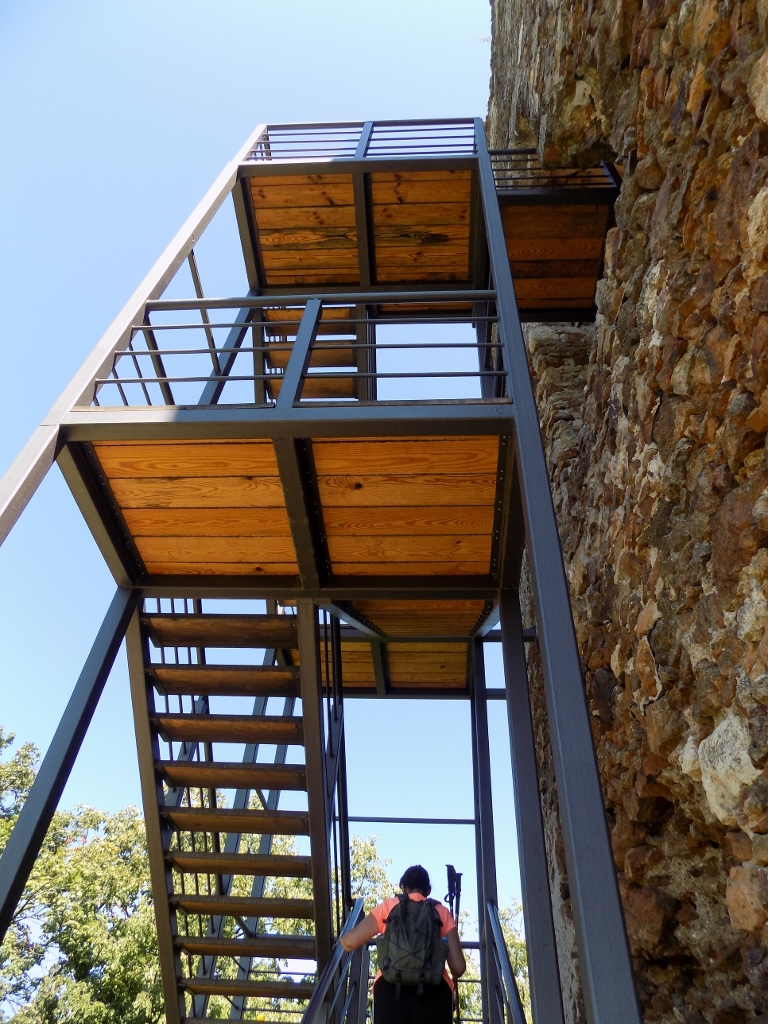 Stairways to the higher sections of the Tower of Vrdnik
Stairways to the higher sections of the Tower of Vrdnik
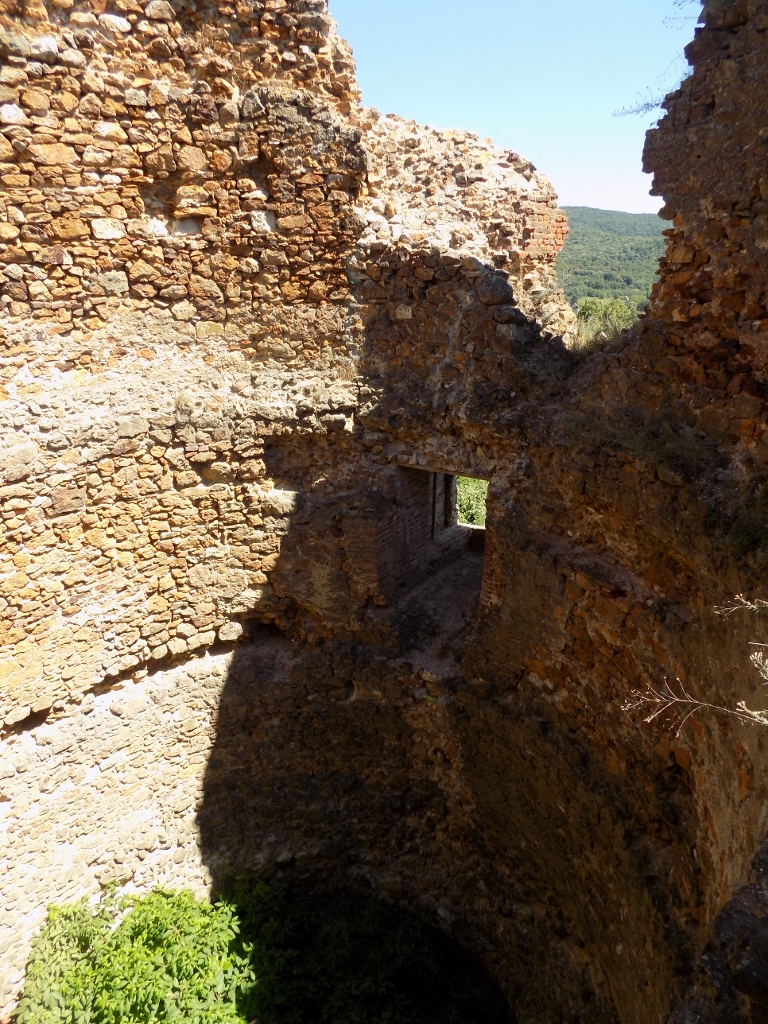 View at the interior space of the Tower of Vrdnik
View at the interior space of the Tower of Vrdnik
When one gets to the highest level of the tower, one can see the surroundings through a window, but the opening is not very big and it is not a particularly suitable place to take photos from. That’s why, when all three of us got back down to the ground, I could have a better view at the south slopes of Fruška gora and farther at Syrmia and central Serbia from a nice clearing beside the tower itself. Then I could also take a photo from there.

After a short break and consultations with mobile phones and the sightseeing plan, we headed along a path where there were few people at first and then there were only the three of us there. We got to a place where there was a large metal construction since obviously there are plans to build a cable car of sorts to Zmajevac viewpoint. However, we were ready to go there on foot. At first sight, it seemed to me as too far, but the three of us were all set and prepared.
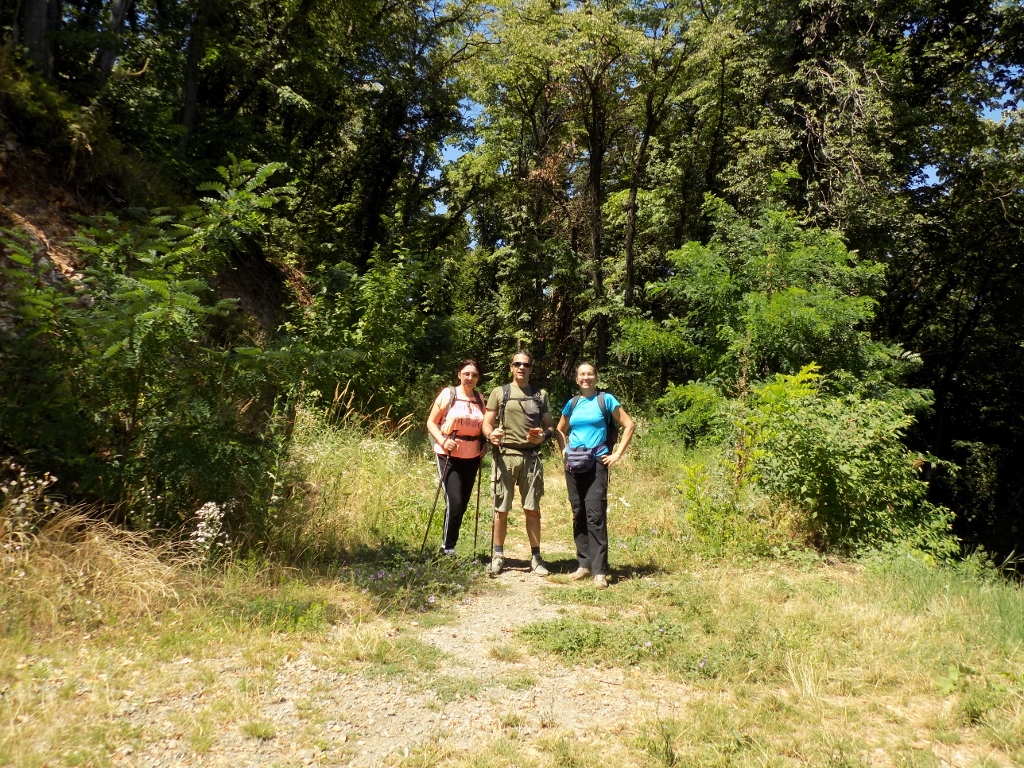 Three hikers
Three hikers
The path lead through a wonderful section of the forest and soon we came across a couple of women walking in the opposite direction.
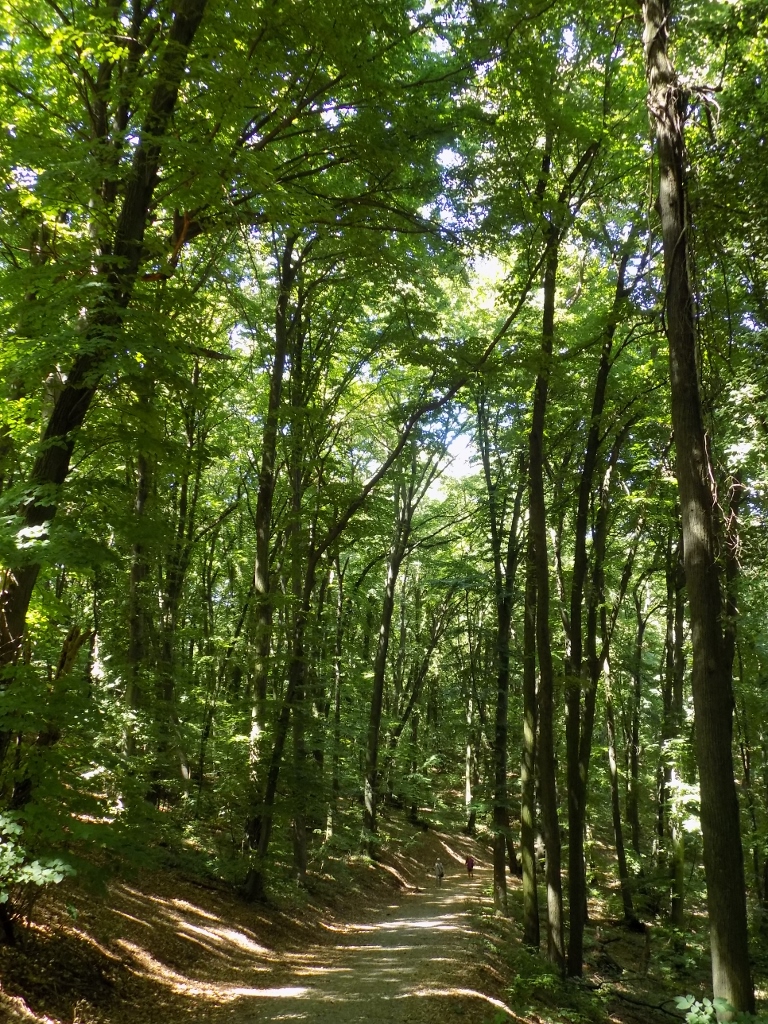 Section of the forest on Fruška gora
Section of the forest on Fruška gora
After a while we reached Zmajevac viewpoint where there is also the other part of the planned cable car. This is still not operational, but from here it was possible to see nicely the elevation with the Tower of Vrdnik on top to which the cable car is going to go.
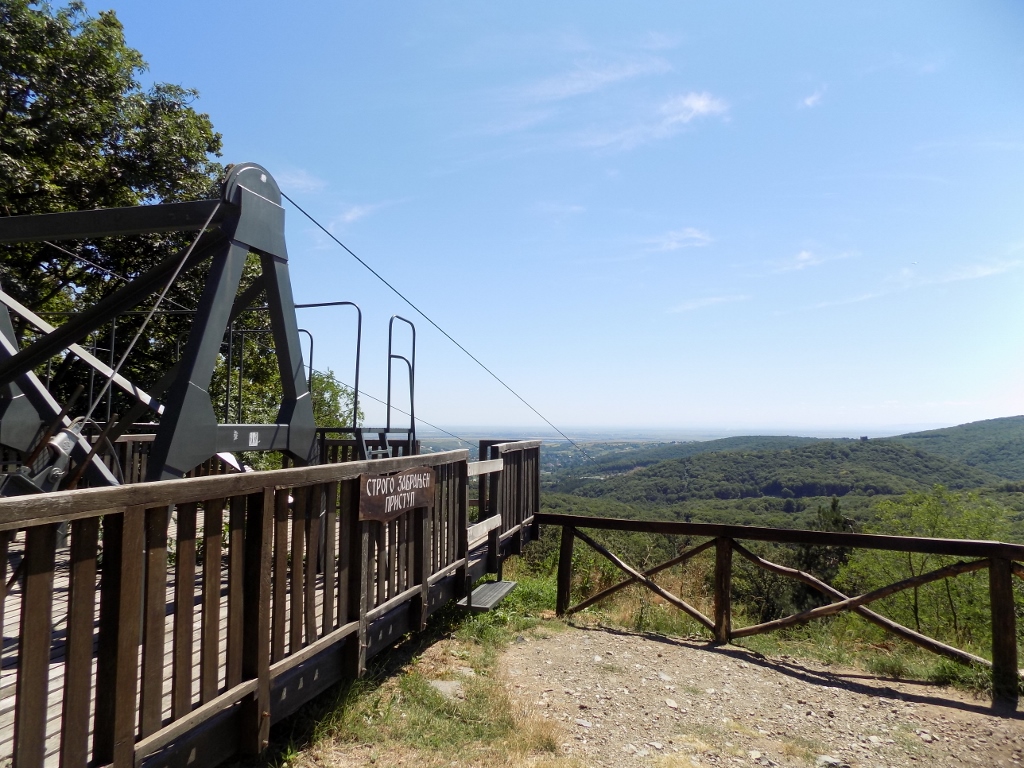 Future cable car at Zmajevac viewpoint, with the Tower of Vrdnik seen in the distance on the right-hand side
Future cable car at Zmajevac viewpoint, with the Tower of Vrdnik seen in the distance on the right-hand side
From the small plateau at Zmajevac viewpoint there is also a very fine view at the south slopes of Fruška gora and Vrdnik.
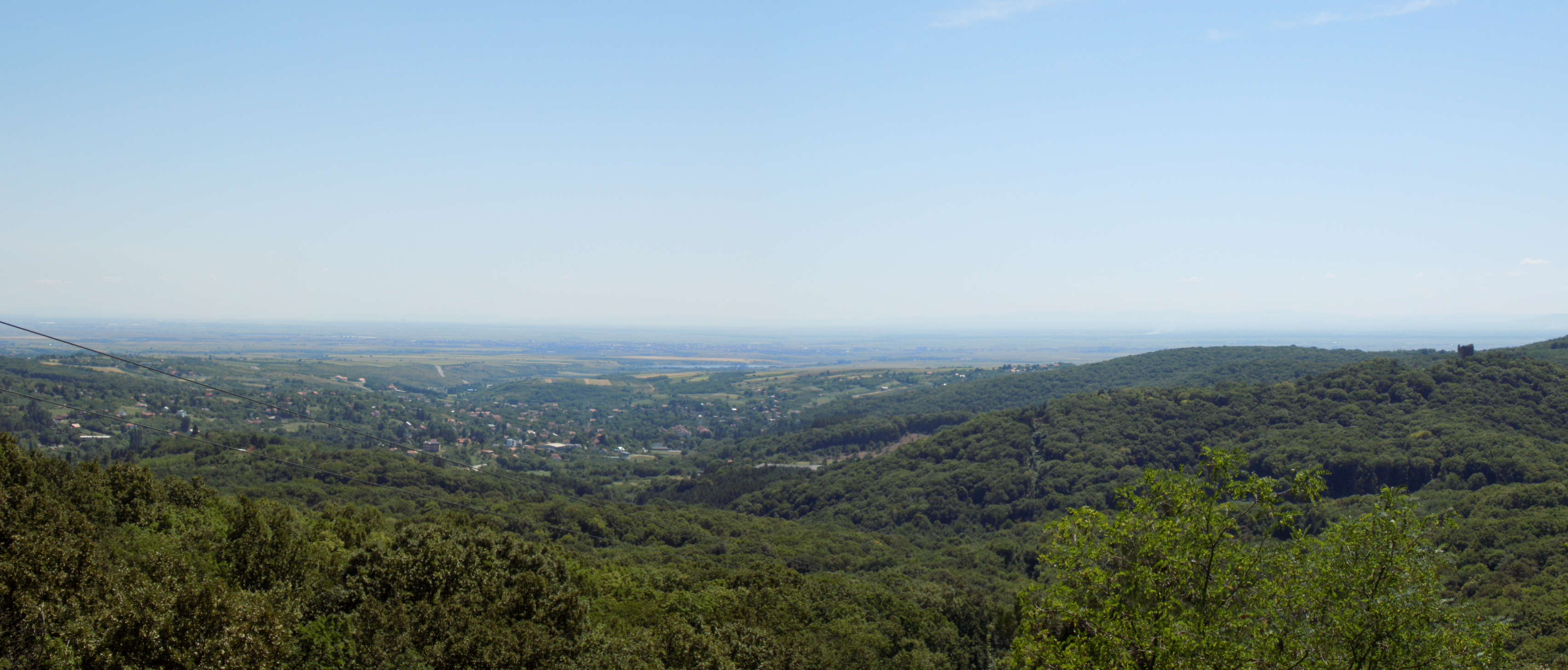
Since it was very hot and that heat tired us even more, we decided here to make a nice and relatively long break, so we walked over to a nearby restaurant where we had some refreshments. We had already eaten the sandwiches we had taken from home and we were not hungry, so we had coffee and water, while dinner was planned for later in Vrdnik itself.
When we rested well, we continued with the hiking, following the map that suggested a path through the forest. Still, first we had to walk along the asphalt road and there we came across a memorial saying that Yugoslav/Serbian politician Ivan Stambolić was killed (and buried) 300 steps farther in the forest. This is a part of our dark (political) past.
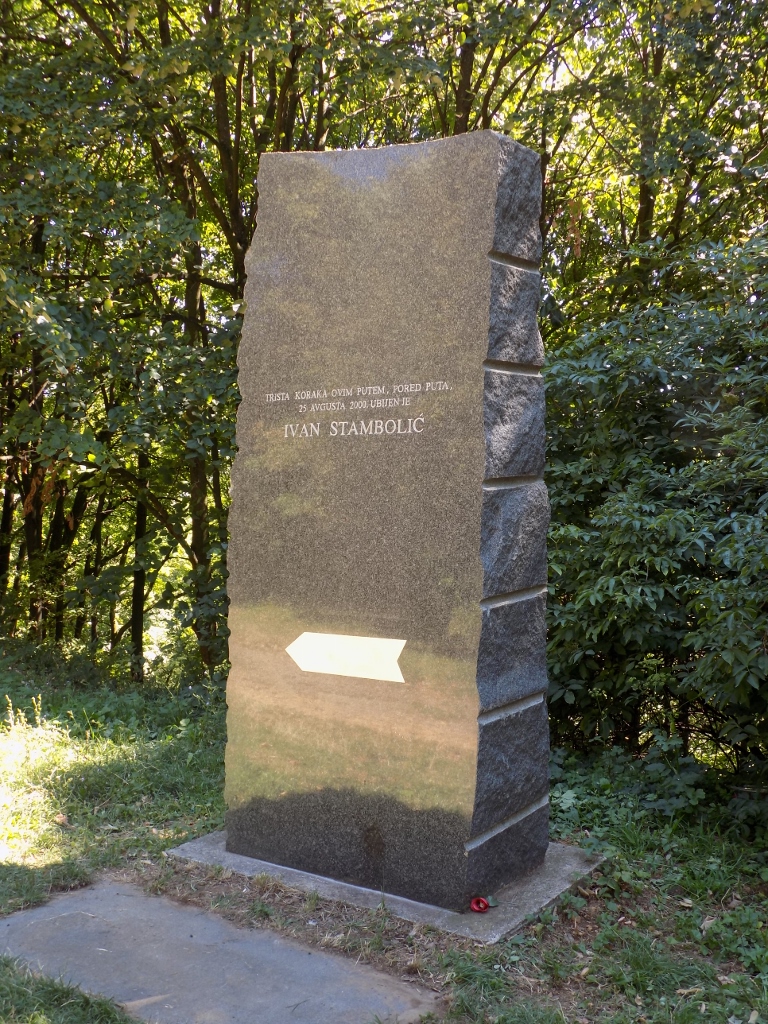 Memorial linked to the assassination of Ivan Stambolić
Memorial linked to the assassination of Ivan Stambolić
We did not go searching for the exact place of the assassination, but simply followed the asphalt road for a short while, after which we entered the forest and headed for Vrdnik along a nice path there.
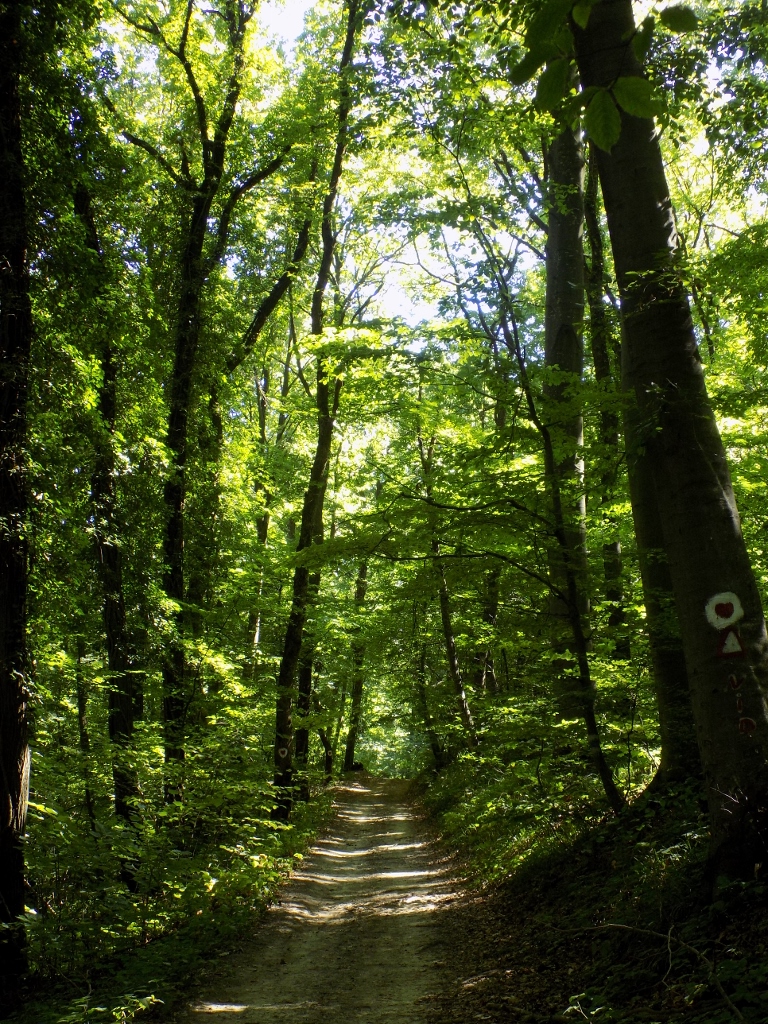 A path through the forest
A path through the forest
After the very pleasant walk through the forest, we reached the first houses in Vrdnik and there we followed a dirt road for a while, after which we got to a street that led by outdoor pools belonging to one of the hotels in this place.
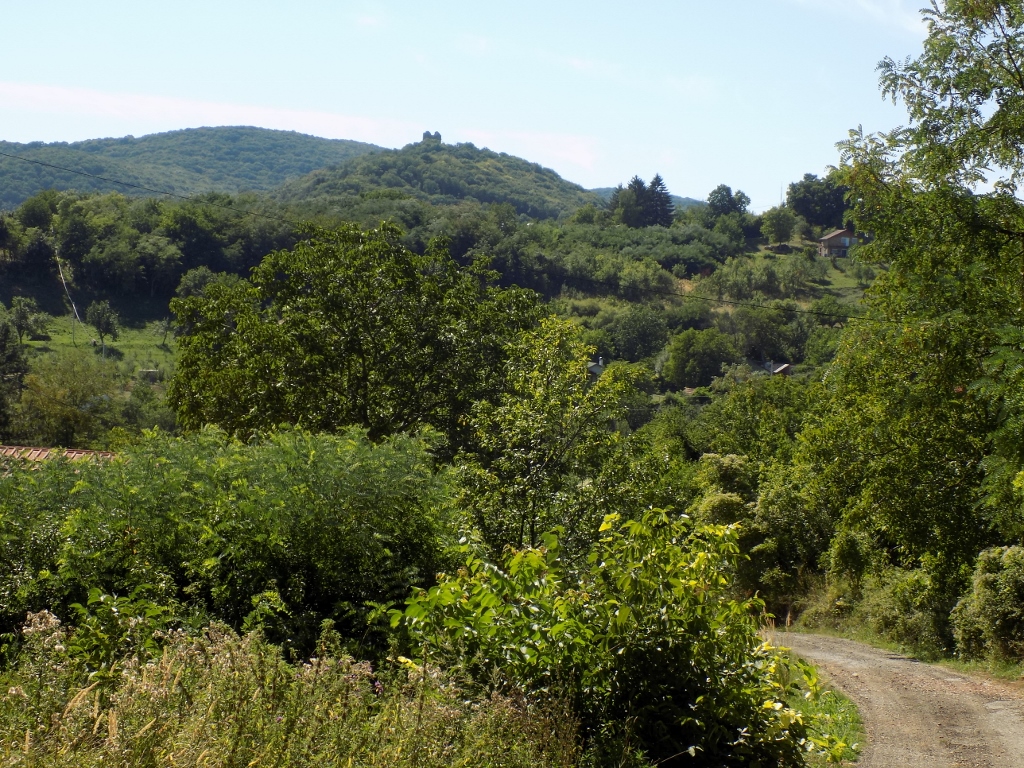 Approaching village Vrdnik
Approaching village Vrdnik
The owner of the suite at which we were staying had given us a recommendation for a restaurant and although we wandered a little, we did find it eventually. The recommendation was quite ok and we had nice dinner and refreshing beer there. After the hiking in hot weather and all the sweating, I think that even 2-3 large beer mugs would not be too much, but I contended myself with just one. Although we certainly rested well while waiting for and during the early dinner, all three of us found the return back to the suite difficult. I tried to remain active and so I took a photo of a tree house we saw on our way back. As a child, I always dreamed of having adventures and I would have certainly loved a house like this.
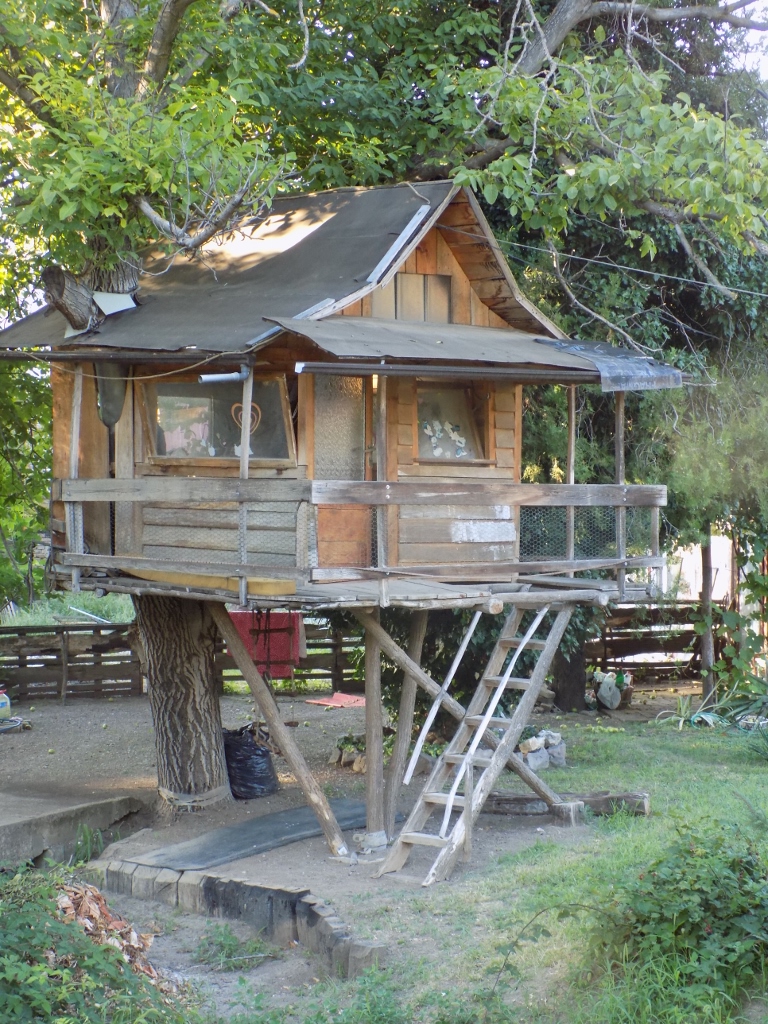 A tree house
A tree house
When we finally reached the suite, as a person of experience I “volunteered” to be the first to take a shower. Oh, it felt so good! Just as good as putting some clean clothes on. The balcony that belonged to our room was small, but Irena arranged the chairs well, so all three of us could sit there and enjoy the pleasant air and the quiet end of the day.
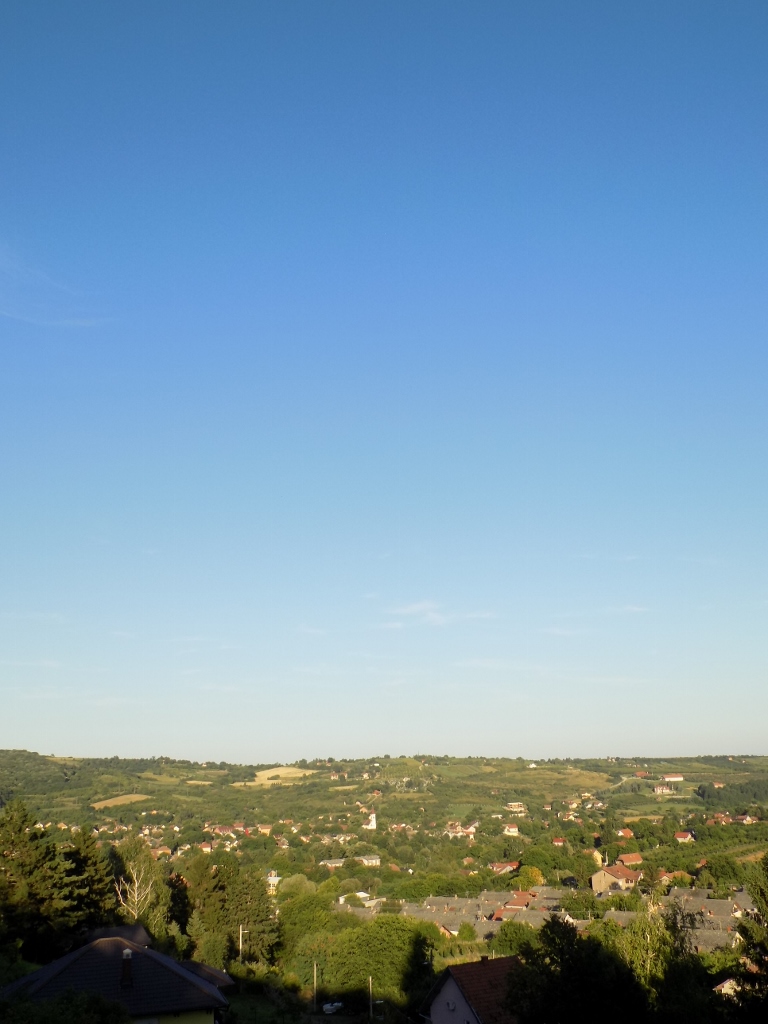 View at Vrdnik at the end of the day
View at Vrdnik at the end of the day
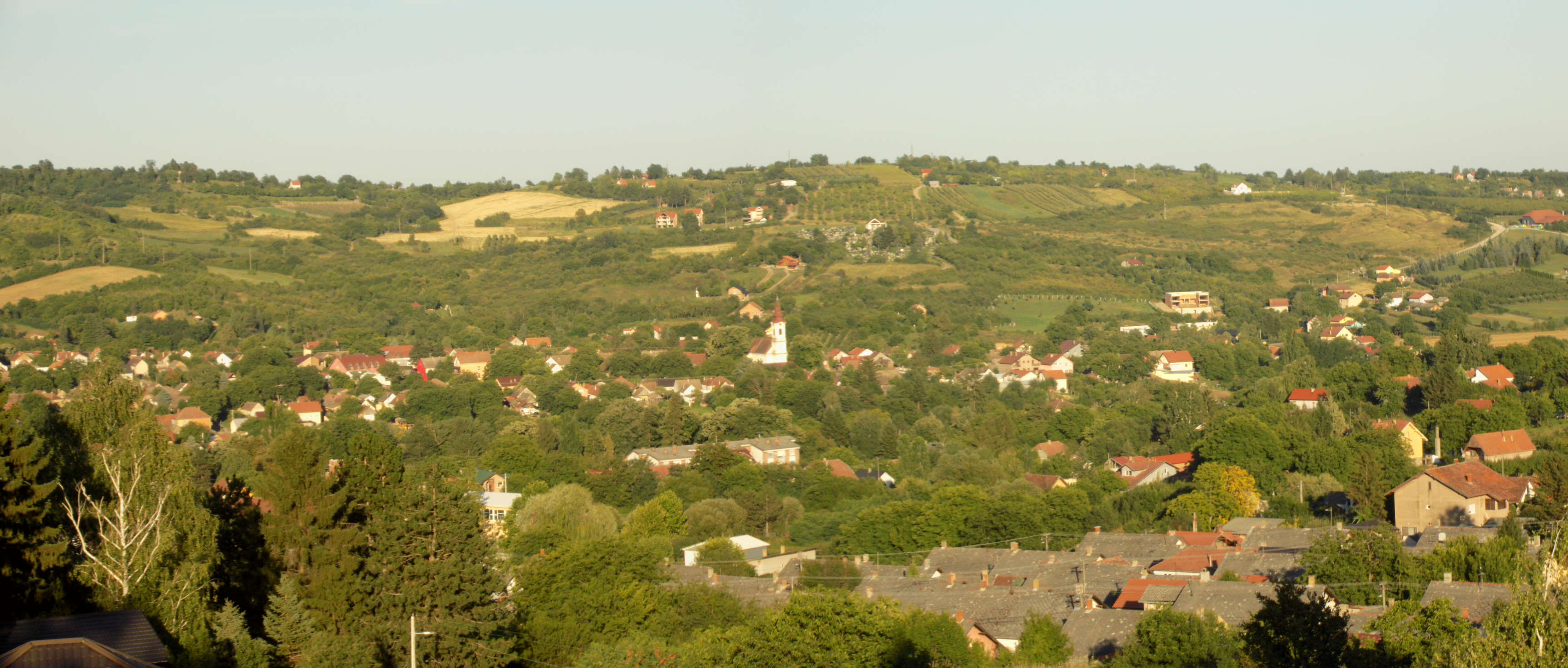
The plan for the following day was to go hiking again, but it was first Igor back at home and now Igor and Irena together that tried to come up with some sensible walk that would include a couple of monuments of culture. The general idea was that we visited the monuments of culture in Vrdnik first and then to drive to one of the monasteries that we planned to visit.
And so, to start with, we drove to the Church of St. John the Forerunner that can in fact be seen in the middle of the photo above. When you get to the church, you first come across a large gate that leads into the churchyard.
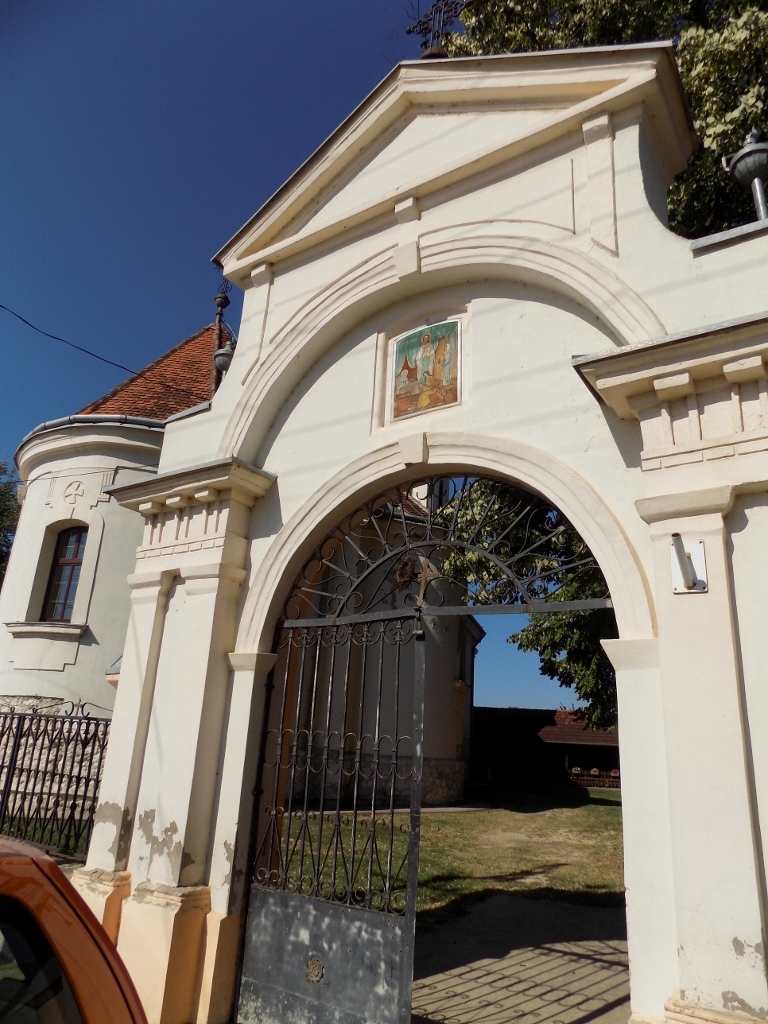 Gate leading into the yard of the Church of St. John the Forerunner
Gate leading into the yard of the Church of St. John the Forerunner
Since it was Sunday and the service was to start soon, there were more people both in the churchyard and in the church. Still, the three of us visited all of this relatively quickly in order not to bother anyone.
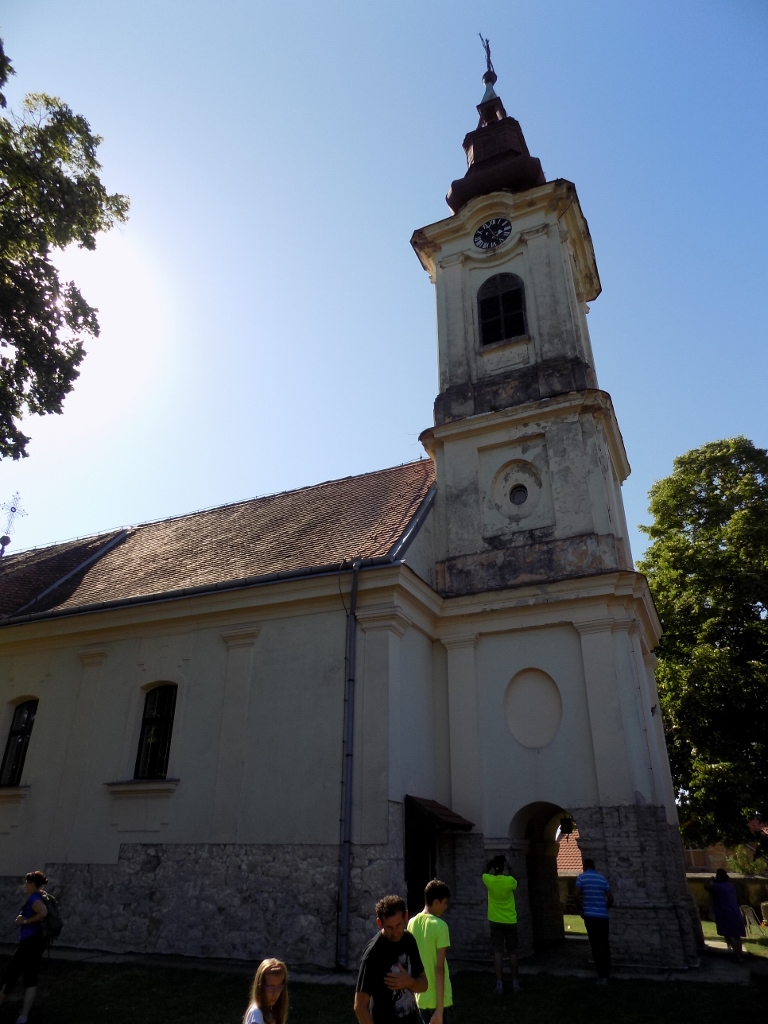 Church of St. John the Forerunner in Vrdnik
Church of St. John the Forerunner in Vrdnik
The church was built in 1777 and today it is a cultural monument of great importance. The ground plan of the church has the shape of a trefoil, which may be discerned from the photo showing the gate, while the bell tower seen in the photo above dates back to 1832.
Here, too, it could be seen on the facades that the restoration was going on (the plaster was stripped off up to a certain height) and this was even more striking inside, where there were smaller or bigger cracks on the walls visible in several places.
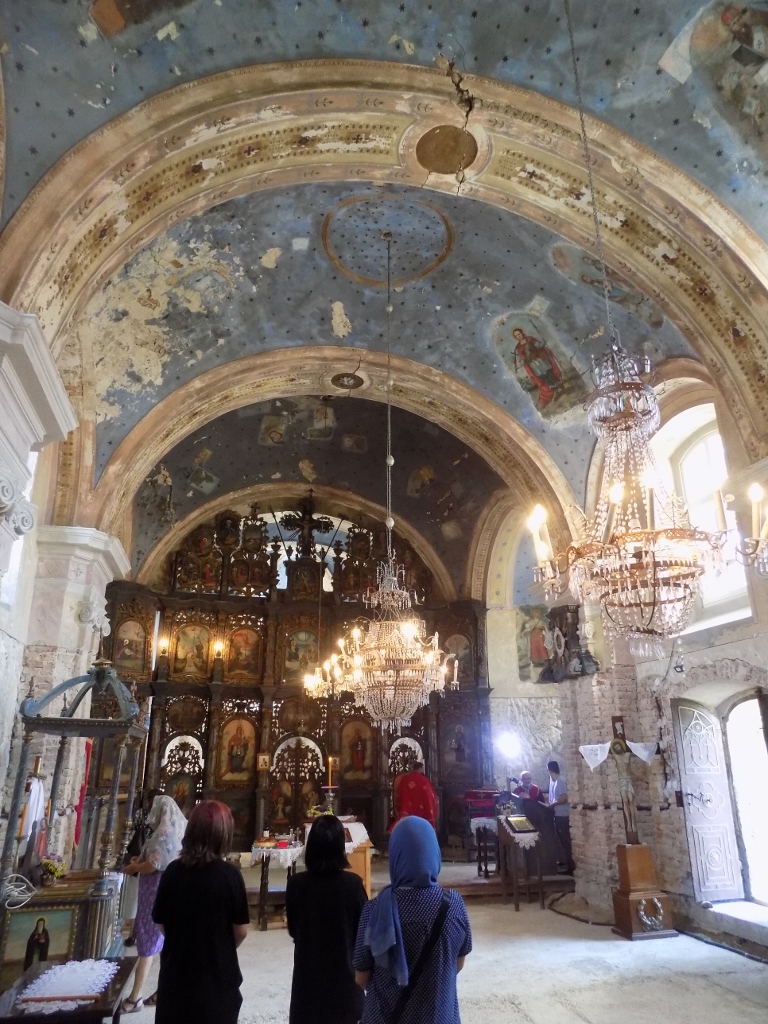 Interior of the Church of St. John the Forerunner in Vrdnik
Interior of the Church of St. John the Forerunner in Vrdnik
At some point the wall paintings were whitewashed, but it seems that this is slowly being restored, too. The Baroque wooden altar partition was made in 1814 and both the iconostasis and the vault were painted in 1825.
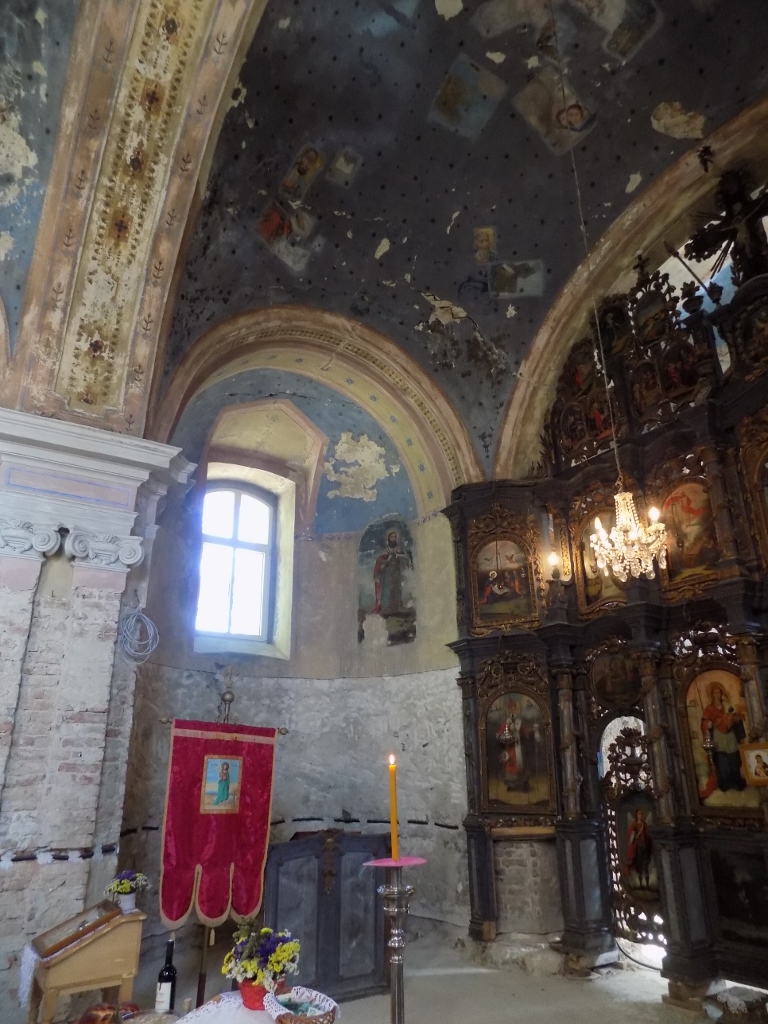 Interior of the Church of St. John the Forerunner in Vrdnik
Interior of the Church of St. John the Forerunner in Vrdnik
After the visit to the church we started with the search of a very special monument of culture. It was – a thermoelectric plant. Namely, a thermoelectric plant was built in Vrdnik at the beginning of the 20th century, being commissioned in 1911, and it used the coal from the local mine, while producing the energy for the operations of the same mine. This is a part of the industrial history and the thermoelectric plant is listed as a monument of culture of great importance (in other words, the second degree of importance among the monuments of culture!). At least this is said at the site of the institution dealing with monuments of culture. In an attempt to find on the map exactly where the thermoelectric plant was, Irena, however, came across the following information and this was published on a site that is not actually dealing with monuments of culture: during the 1999 NATO bombing of Serbia, the thermoelectric plant suffered collateral damages and then came the local authorities which demolished the structure to the ground, while using the metal parts and the bricks for the construction of residential and business buildings. If this does not sound horrible enough, there is also another piece of information saying that “to this very day the judiciary have not processed this total devastation.” Powerless to change anything about any of this, the three of us agreed that at least we wanted to see what a “total devastation” looked like. However, even this was not possible, since the entire plot was overgrown and we were not in the mood to try to make our way through the dense vegetation.
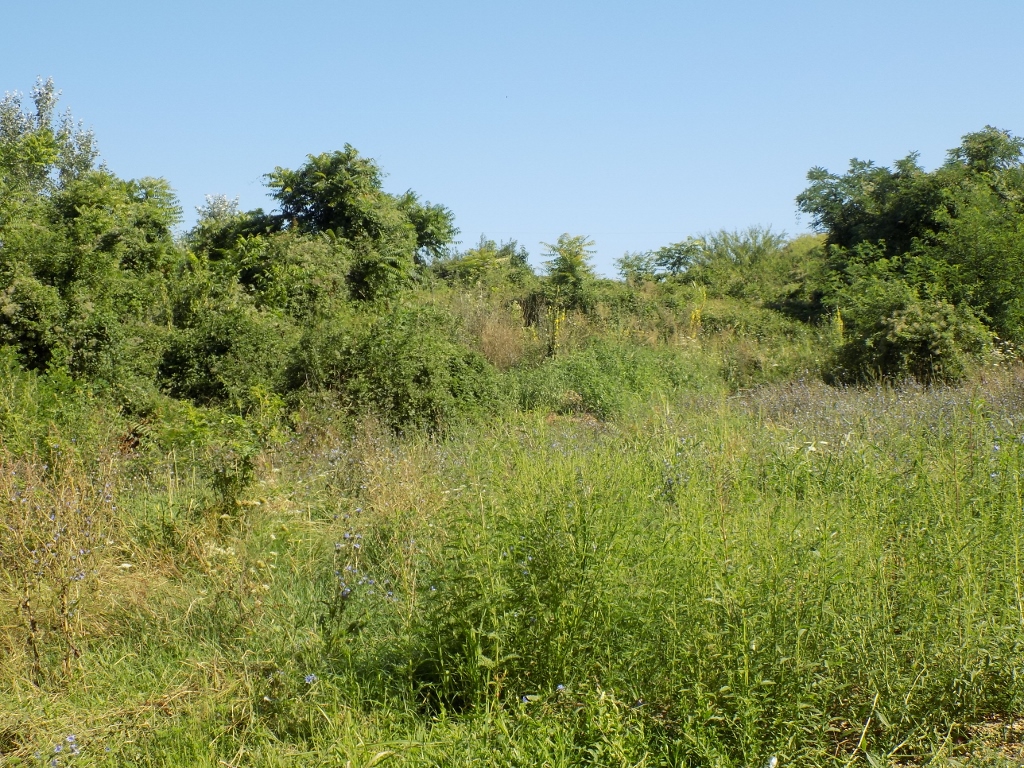 This is what could be seen in August 2020 in the place of the former thermoelectric plant in Vrdnik
This is what could be seen in August 2020 in the place of the former thermoelectric plant in Vrdnik
The next monument of culture was not easy to find either, since none of the maps (I’m thinking of digital maps) has a well marked position of this place. This is a house in which a 19th-century Serbian poetess, Milica Stojadinović Srpkinja (1828-1878), used to live. This is also a cultural monument of great importance. We asked a couple of local residents and so we managed to get to the house which is located at Vojvođanske brigade street no 75.
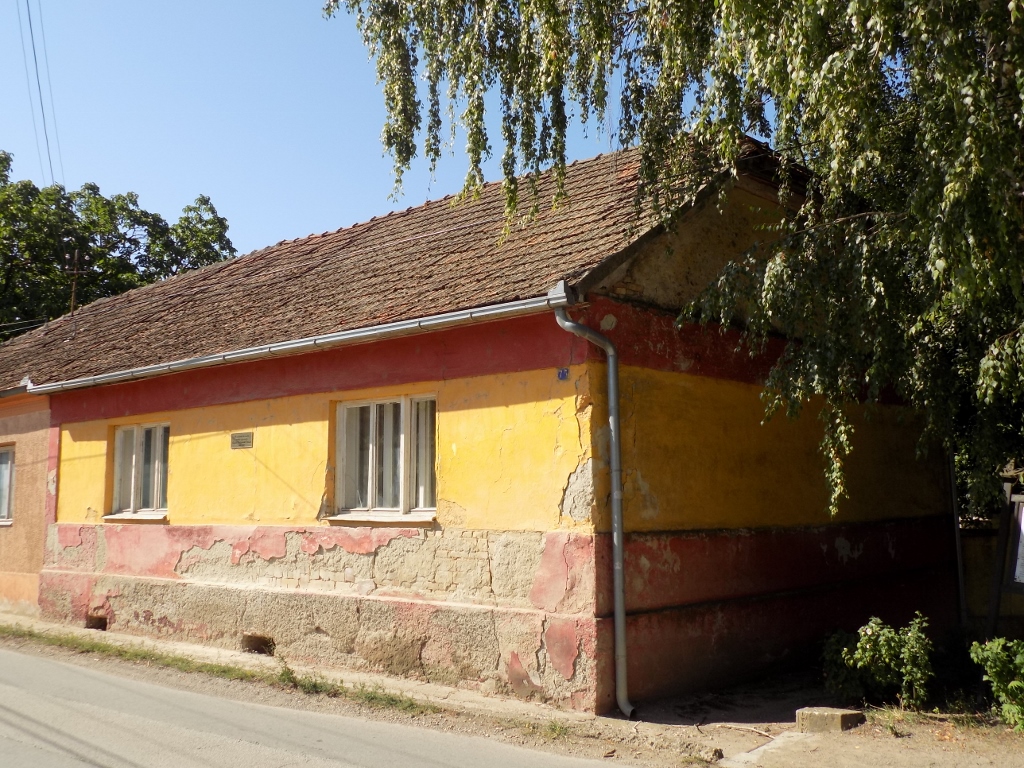 House in Vrdnik in which Milica Stojadinović Srpkinja used to live
House in Vrdnik in which Milica Stojadinović Srpkinja used to live
The house was built in the 19th century and that was all I could find on this house. I looked at the courtyard over the fence, but it all seemed deserted. Milica lived here until she moved to Belgrade towards the end of her life where she eventually died in utmost misery. She was first buried in Belgrade and in 1905 her remains were transferred to Požarevac where they were buried in the family’s tomb. By the way, among other things, what is interesting about her is that in addition to being very well educated she was also very beautiful and so Njegoš (a Prince-Bishop of Montenegro) said about her: “I’m a poet and she is a poetess. Were I not a monk, Montenegro would now have a princess.”
Here we finished with our sightseeing of Vrdnik and so we moved to the next village and Jazak Monastery by car. Still, soon at some point, I did stop since right next to the road there was another monument of culture and this one was a monument erected for the killed members of the Jovičić family. It is categorised as a landmark.
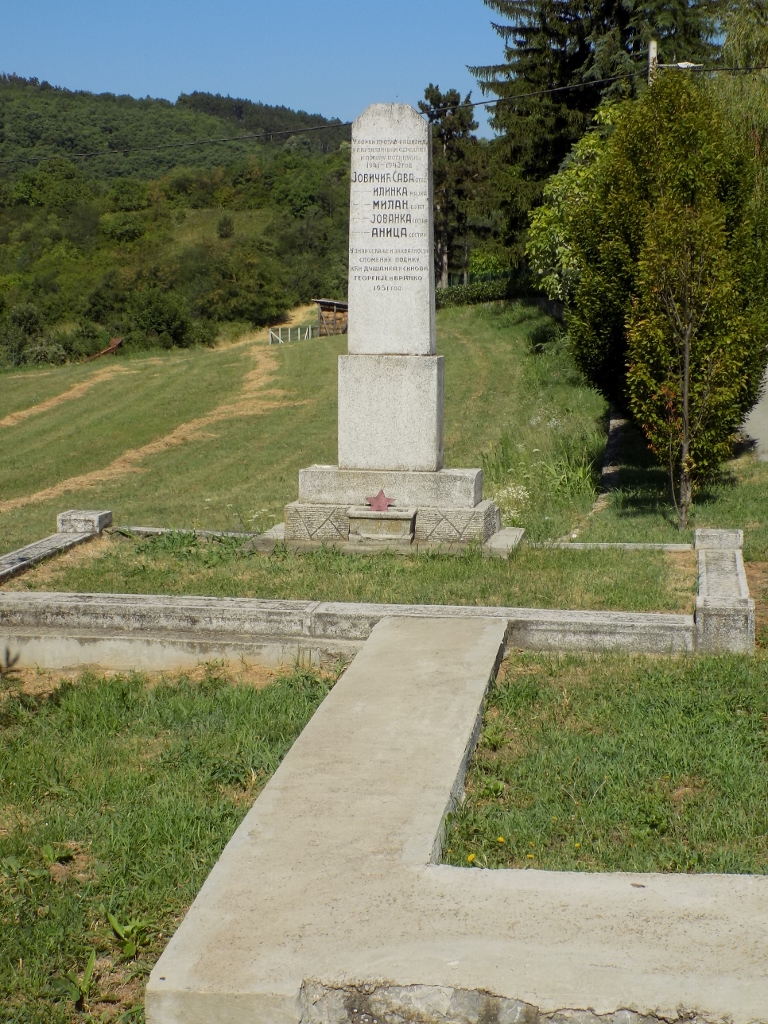 Monument for the killed members of the Jovičić family
Monument for the killed members of the Jovičić family
The monument is a typical family monument of the gravestone type and it was erected for five members of the Jovičić family (father, mother, one son and two daughters) who were killed during WWII as members of the resistance movement. The monument was erected in 1951 by the surviving children (one daughter and two sons).
At the entrance into village Jazak, we turned onto a side road and soon we saw the bell tower of Jazak Monastery.
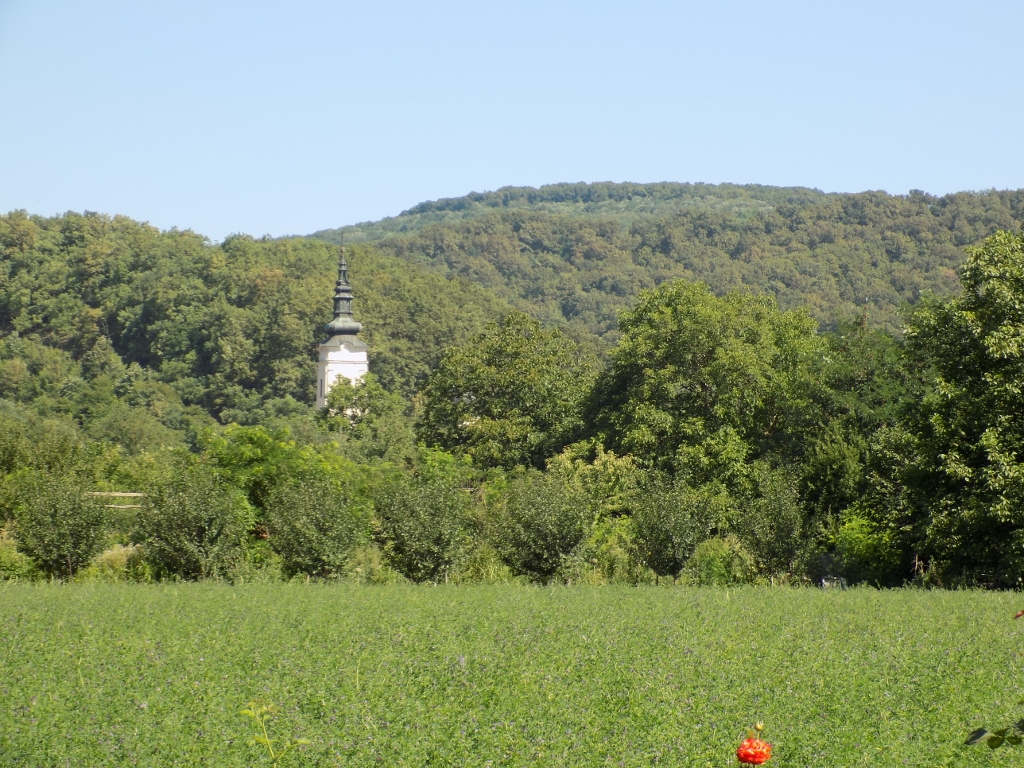 Approaching Jazak Monastery
Approaching Jazak Monastery
Jazak Monastery, a cultural monument of exceptional importance, was built in 1736 and it incorporates the Church of the Holy Trinity around which there are dormitories and a high wall that enclose the churchyard.
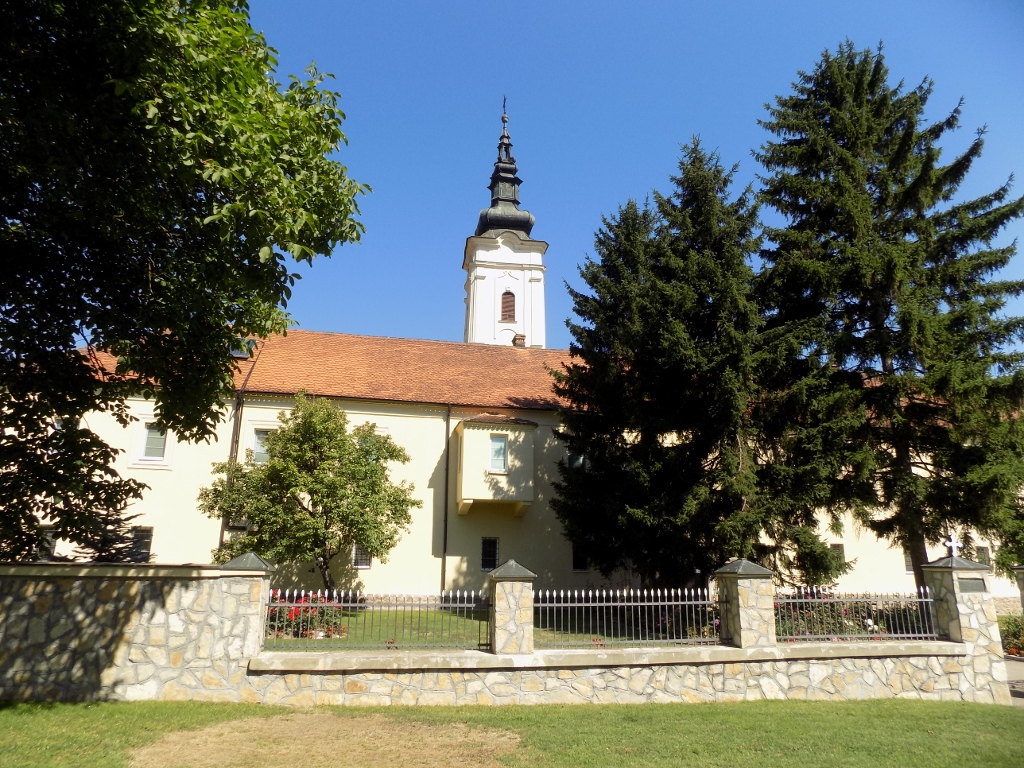 Jazak Monastery
Jazak Monastery
The architectural characteristics include the triconch ground plan and a dome with a ten-sided drum, while the bell tower was added at the beginning of the 19th century.
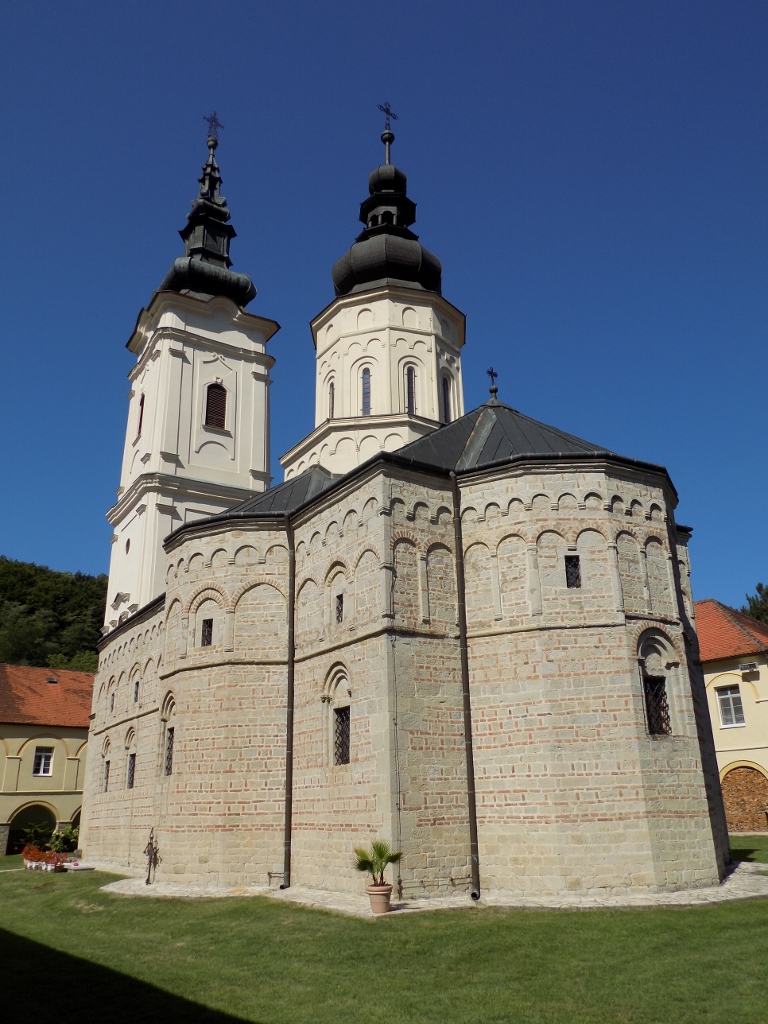 Church of the Holy Trinity at Jazak Monastery
Church of the Holy Trinity at Jazak Monastery
It was not permitted to take photos inside the church, so there are no images of the interior in this story, but I can say that the church has been completely restored and it is very nicely kept, so it is certainly well worth the visit. In addition to the beautiful Baroque iconostasis, the visitors should pay attention to three opulently decorated thrones adorned by icons that date back to the second half of the 18th century.
Since I could not take photos of the church from the inside, here is another one from the outside.
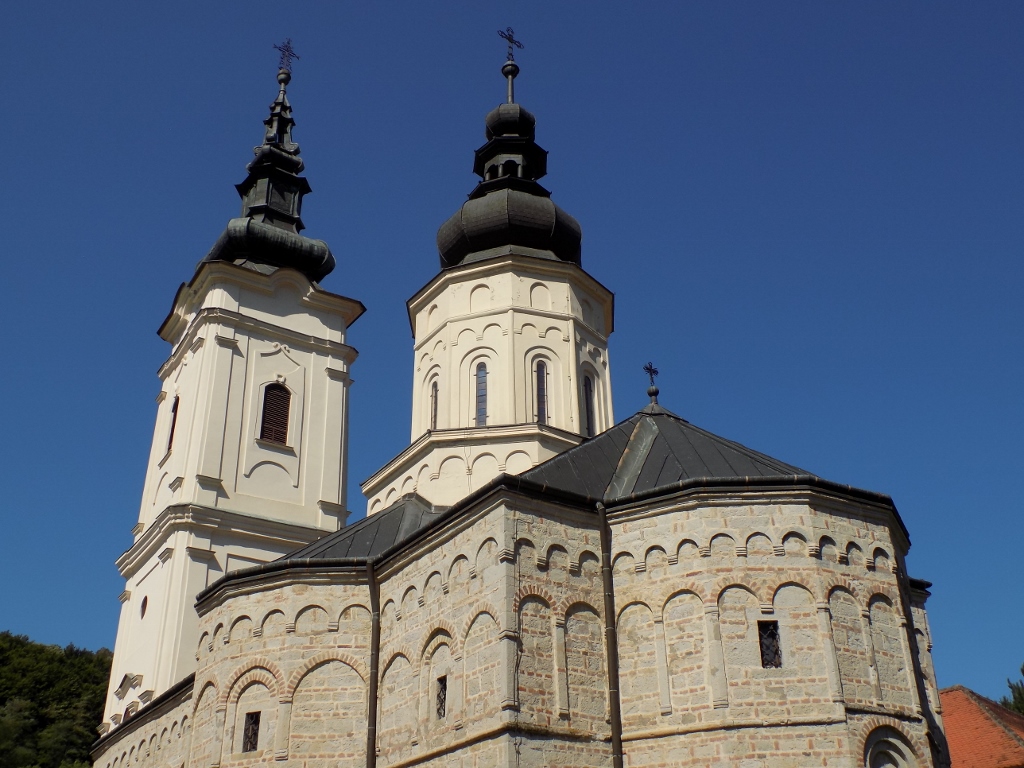 Church of the Holy Trinity at Jazak Monastery
Church of the Holy Trinity at Jazak Monastery
Since I parked my car in a nice shade here, after the visit to the monastery, we got our respective trekking poles, put our backpacks on and started with the walk. The weather forecast for the day said that it would be even hotter, so our goal was to get into the forest. Still, on our way to the forest we passed by numerous bushes of wild blackberries. Needless to say, we picked and ate some and I was almost sorry I did not have some lidded box with me to forage some in order to take them home. Admittedly, Irena offered such a box she had with her, but foraging blackberries was more of a good idea than a realistic plan. There were also too many stinging nettles around the blackberry bushes.
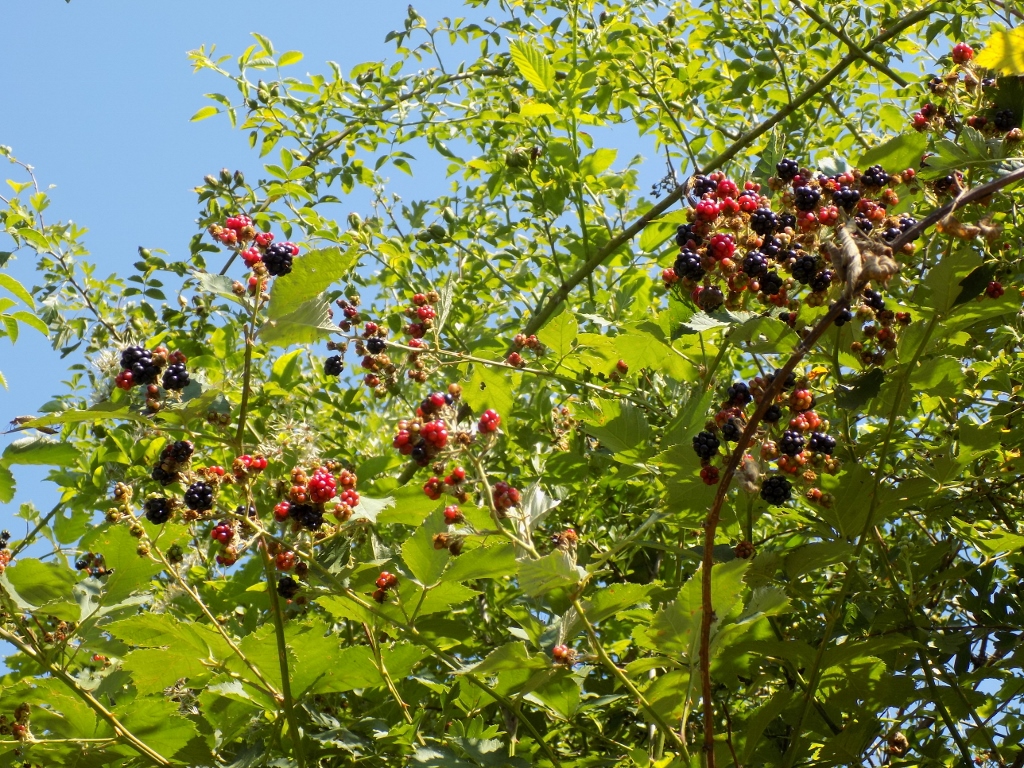 Wild blackberry that has grown up so much here that it is taller than me
Wild blackberry that has grown up so much here that it is taller than me
Along the way I also noticed an interesting wild bee specimen. This was a violet carpenter bee (Xylocopa violacea). Since I was standing directly in the sun, I could not be patient enough to follow it and possibly take a better photo, but I think the next one is not too bad. It is certainly a nice memory.
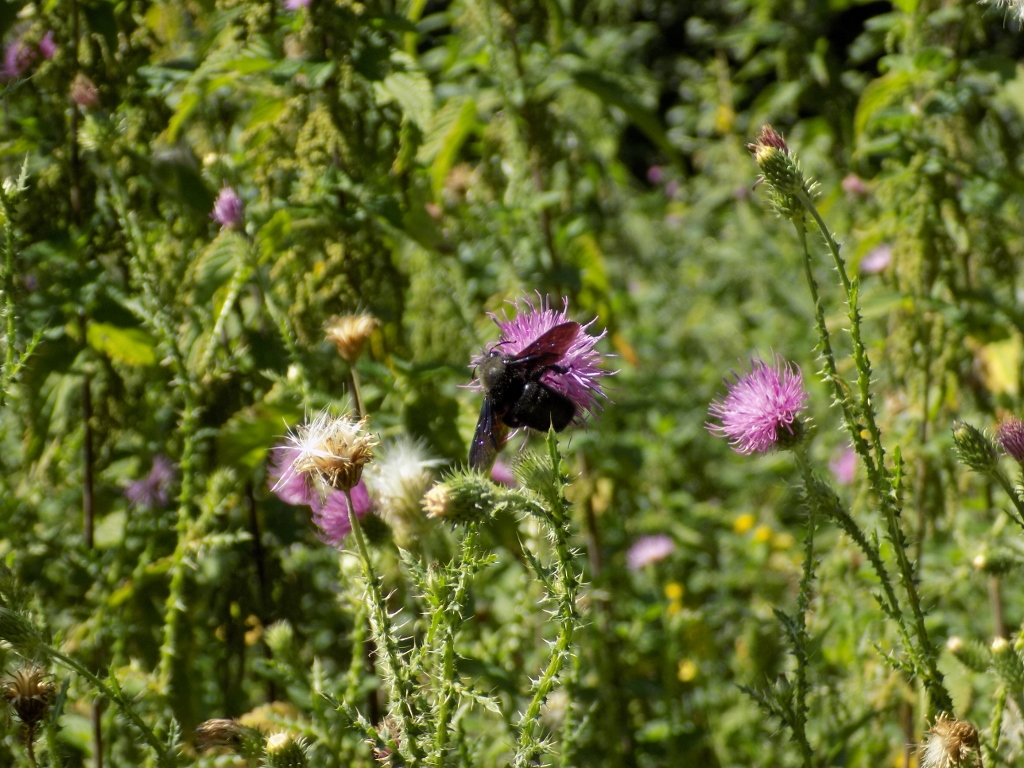 Violet carpenter bee
Violet carpenter bee
And then we reached the forest and thought that we were out of the woods, so to speak, and that we would enjoy.
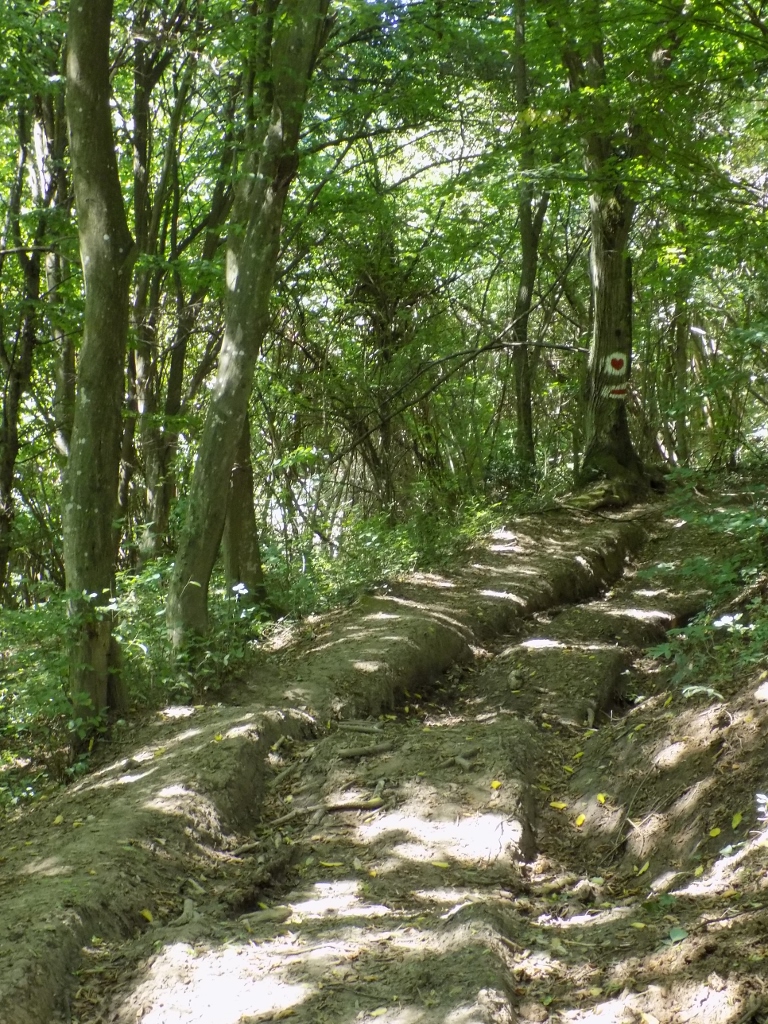 Walking path through the forest
Walking path through the forest
Well, it may have been enjoyment, however, not for us, but for the incredibly numerous mosquitoes that must have been very hungry and they threw themselves at us with all their might. I was the only one with long trousers, so in the end I had fewest problems. The point is that the path led very close to a stream, plus it had rained a few days earlier and so the humidity in the forest was high and this all led to such a large number of mosquitoes. They were so much onto us that we made almost no stops whatsoever, but rather hurried through the forest in order to get to the end of the path leading through it as soon as possible.
It was a pity, though, since the forest was truly beautiful, but there was nothing we could do about it. I stopped very briefly in a couple of spots in order to take a photo and that was it.
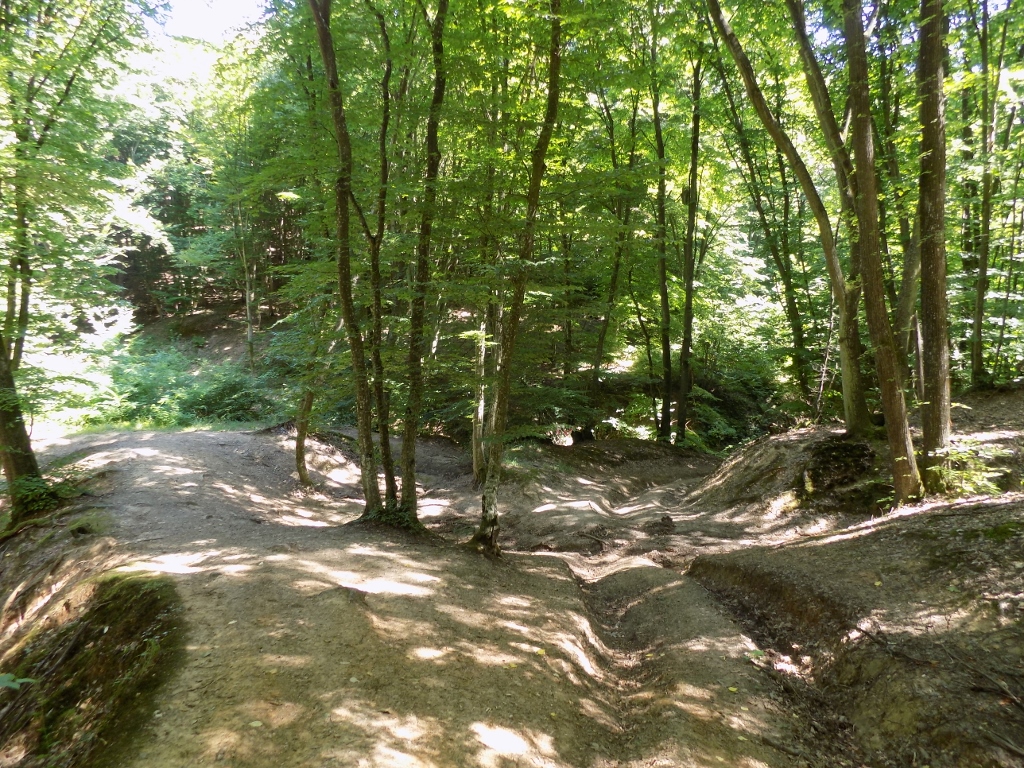 Walking path through the forest on Fruška gora
Walking path through the forest on Fruška gora
At some point, in the middle of the forest, we got to a memorial marking the place where Boško Palkovljević-Pinki (1920-1942), one of the first partisans declared a National Hero (already in 1943), was killed on 10 June 1942. These are certainly events linked to WWII. He was one of the most popular national heroes in the former Yugoslavia and so numerous streets and institutions were given his name. In Zemun, a part of Belgrade, there is a cultural and sports centre with his name – Pinki Hall.
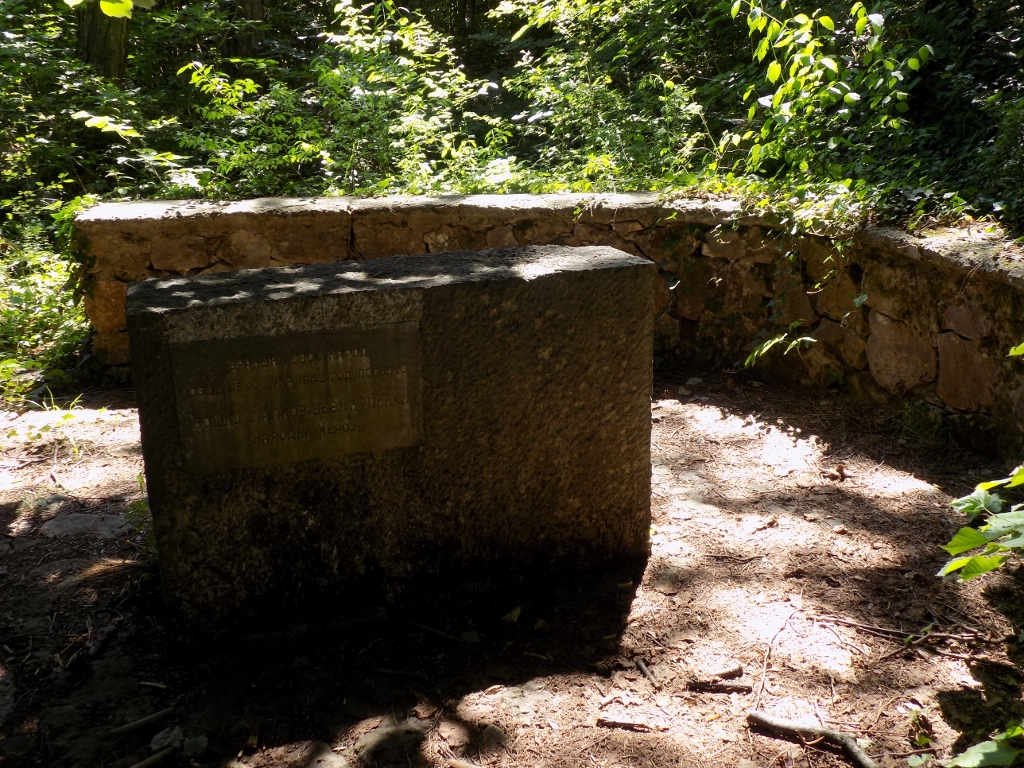 Memorial dedicated to Pinki
Memorial dedicated to Pinki
Still, without any break to speak of, we continued hastily along the path and were very content when it finally got us out of the forest and to an asphalt road. We were breathless with all the hurrying, but very happy that the pests were left behind. Precisely there, on the other side of the road, we saw a fenced-off plot of land with a walnut orchard and there was such a wonderful shade there, with clearly no mosquitoes, so we decided to have our break there. Irena had a mat and I proposed that we climbed over the fence and sat right under a walnut tree since the grass was nicely maintained and low, plus there was more space there. Igor was the only decent member of our trio and he did not trespass, but Irena and I sat down on the mat and enjoyed thoroughly.
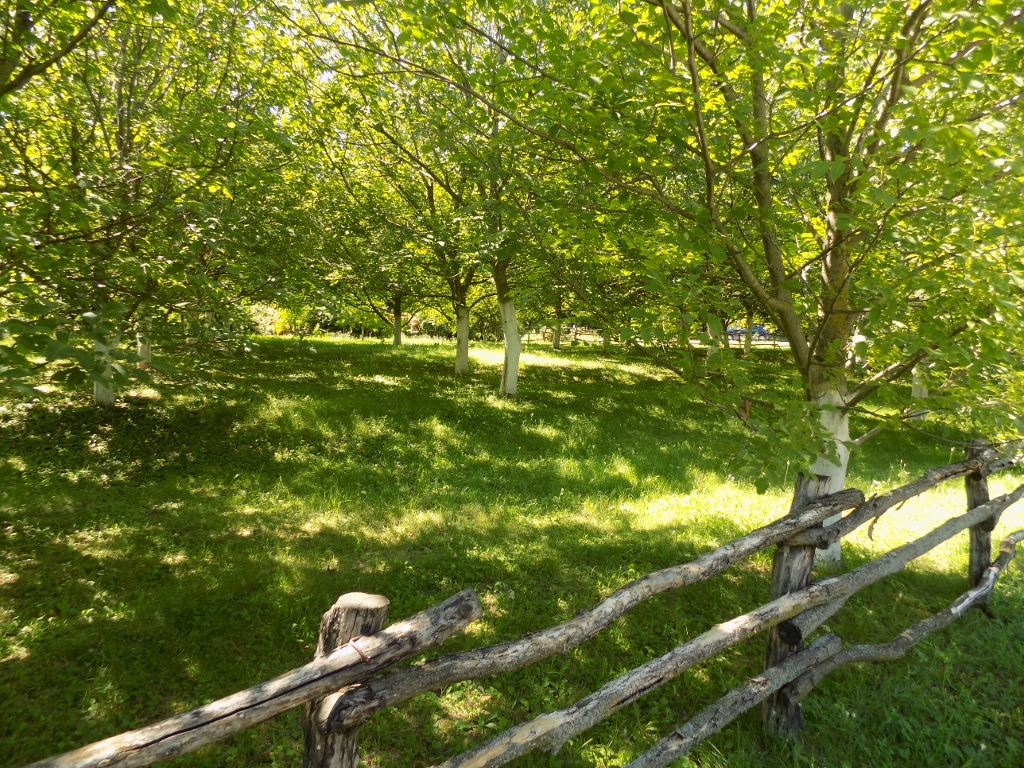 A part of the plot with walnut trees
A part of the plot with walnut trees
All of a sudden, there came the owner. A serous man, he looked at us calmly and I started immediately to justify ourselves: “Please, excuse us, we just sat here for a little while to have a rest.” With his face still very stern he said we would have to pay. I was puzzled, but soon enough it turned out he was only joking. Moreover, after a short conversation about the walnuts and the mosquitoes, he invited us for coffee at his place. How could we say no to such a kind invitation? He lives there with his wife, so we first sat at the table in the garden where he positioned a parasol and then his wife went to make the coffee.
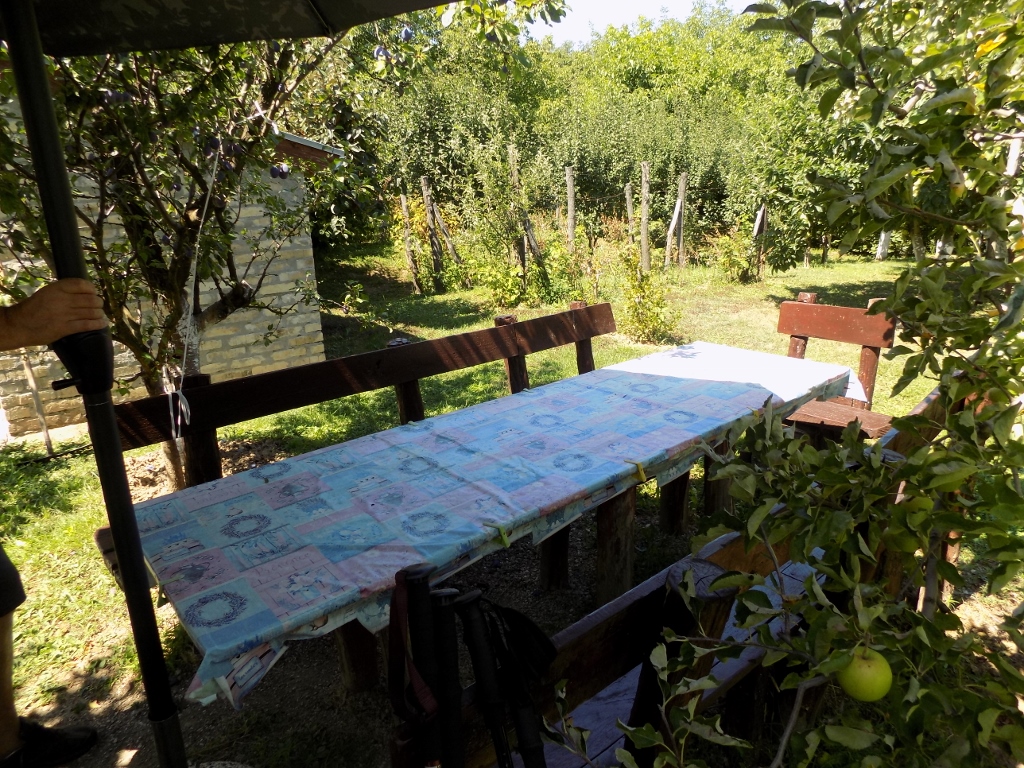 The parasol is being installed above the table where we are about to sit
The parasol is being installed above the table where we are about to sit
We settled nicely there and then he told us about what he was doing generally in his life and what he was growing there, since there were many fruit trees in the garden.
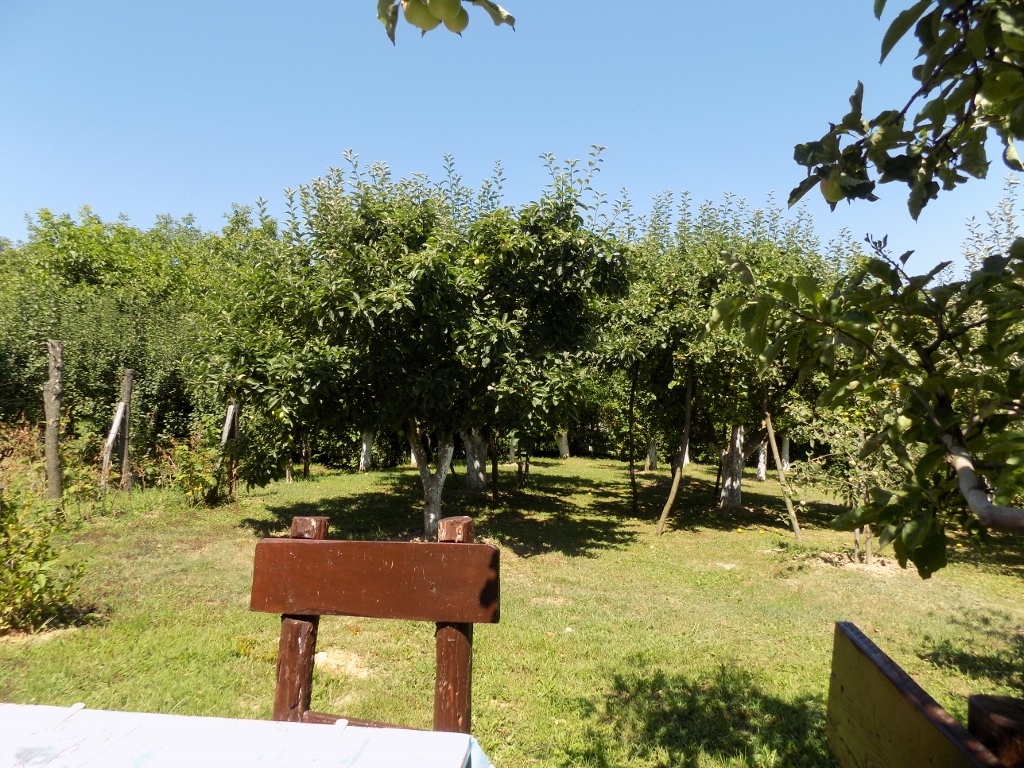 A part of the orchard
A part of the orchard
Then our kind host went to the nearby trees and picked some fresh plums for us, while his wife soon returned with homemade strawberry juice and the coffee.
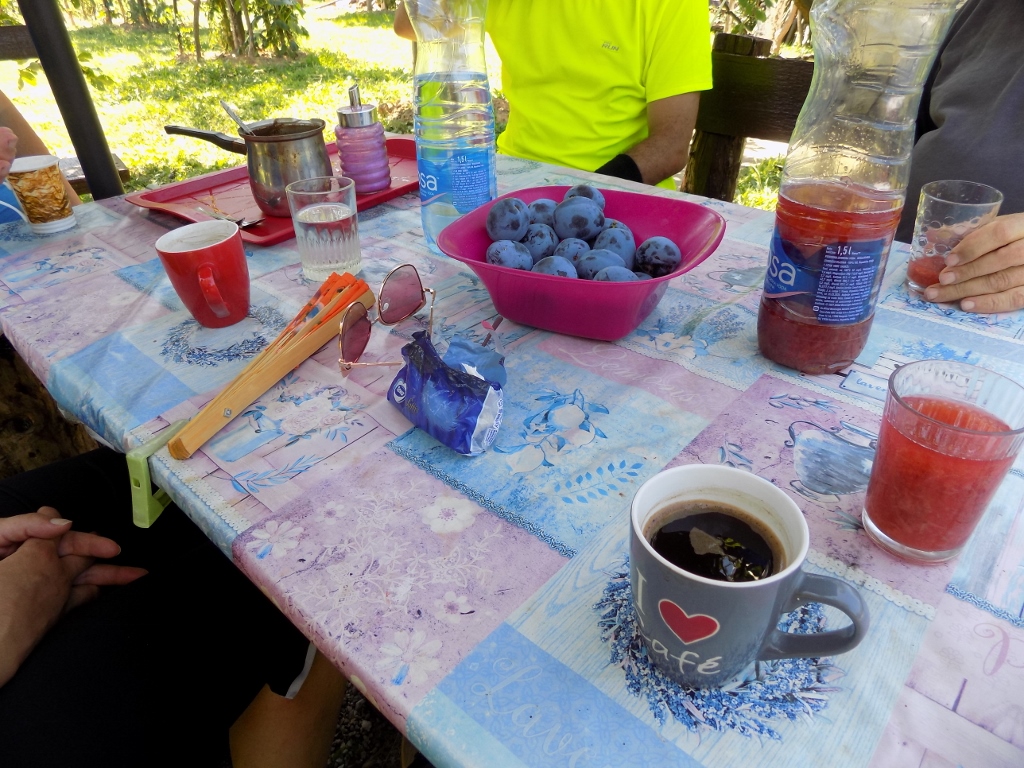 A proper, unexpected feast
A proper, unexpected feast
We chatted quite nicely and then the host also told us about how he sundried his plums, showing us photos of his products, and then he also brought us some homemade prunes to try. Still, no matter how wonderful and kind these people were and how much we enjoyed talking with them while sitting in the nice shade, at some point we did have to leave. Needless to say, they insisted that we took all of the uneaten plums and prunes. As a nation, we, Serbs, have different flaws, but we also have some great virtues, one of them being hospitality.
We continued with our walk following a road from this sort of settlement with weekend cottages via Široke ledine picnic area. It was sunny and it was very hot, but there were no mosquitoes. After the earlier experience this was not negligible.
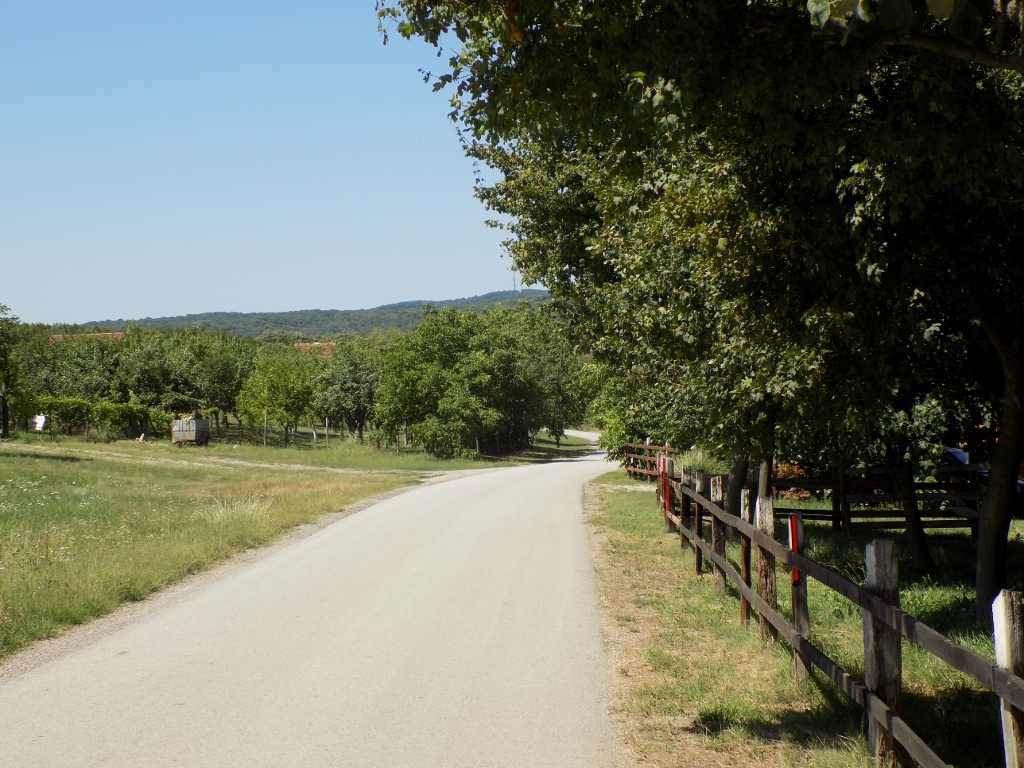 Leaving the weekend-cottage settlement behind
Leaving the weekend-cottage settlement behind
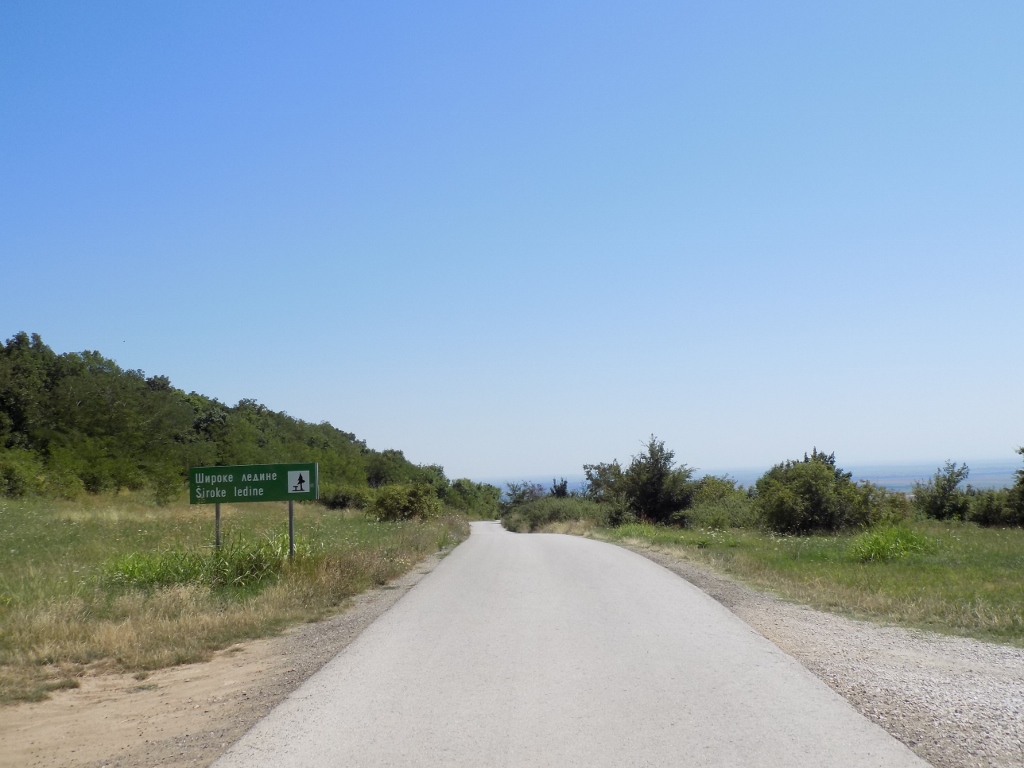 Road leading beside the Široke ledine picnic area
Road leading beside the Široke ledine picnic area
We were descending again towards the southern foot of Fruška gora and at some point we came across a clearing beside the road from where there was a stunning view at south Syrmia.

Our next destination was Mala Remeta Monastery. It is a monument of culture of exceptional importance. The entrance into the space of the monastery and the access to the church were very pretty, since the road leads between tidily planted fruit trees.
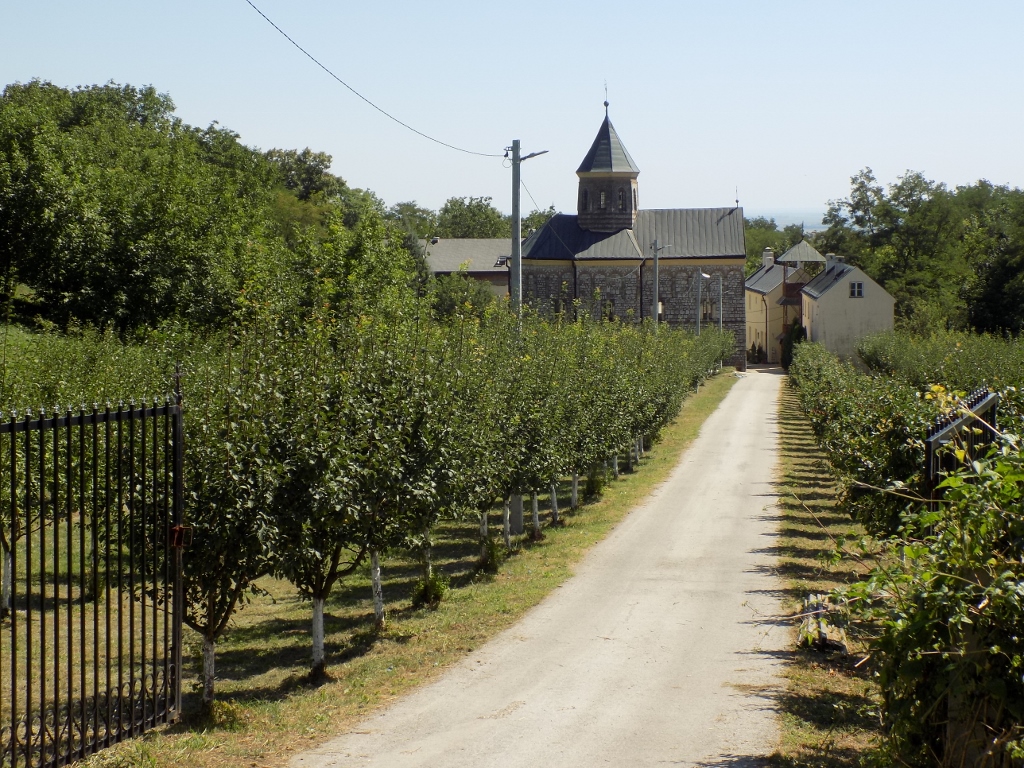 Mala Remeta Monastery
Mala Remeta Monastery
Although there is data that suggests that the monastery was founded back in the 13th century, the first reliable mentioning of the monastery dates back to 1546, but it was burned down afterwards. It was renewed again at the end of the 17th century and it got its present-day appearance around the middle of the 18th century.
The church is dedicated to the Intercession of the Holy Virgin and it is of smaller dimensions in comparison to the other monasteries of Fruška gora, but I liked it quite a lot with its picturesque facade and the stone decoration.
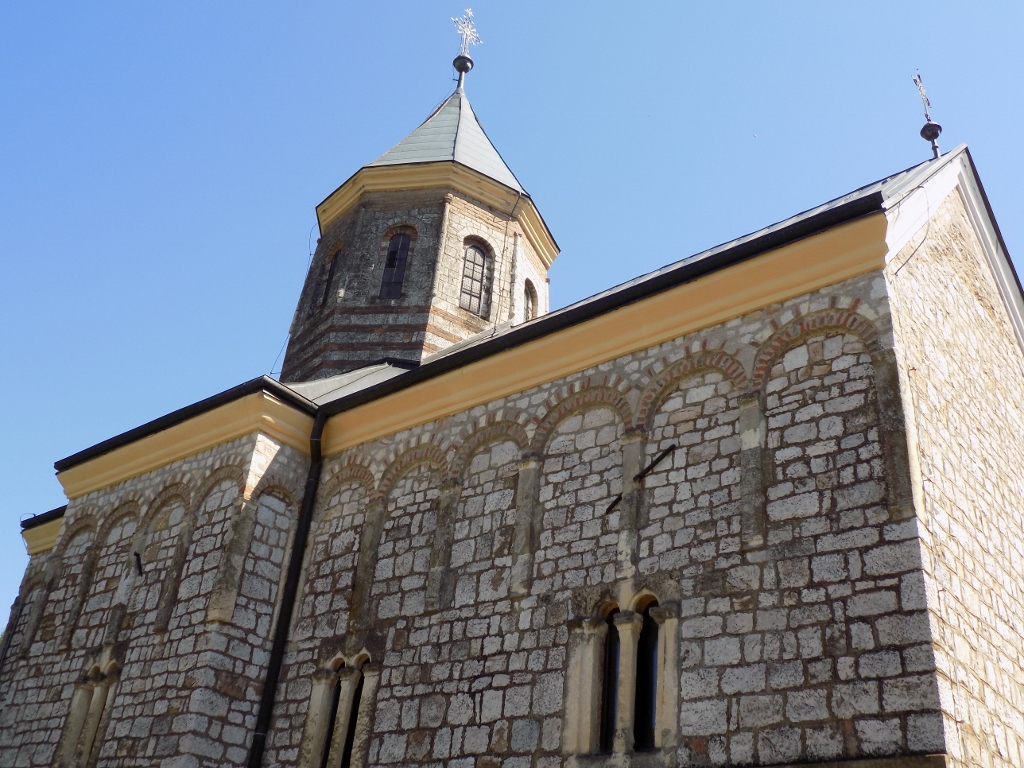 Church of the Intercession of the Holy Virgin in Mala Remeta Monastery
Church of the Intercession of the Holy Virgin in Mala Remeta Monastery
This is a single-nave building, which is dominated from the outside by an octagonal dome, while inside there is a barrel vault.
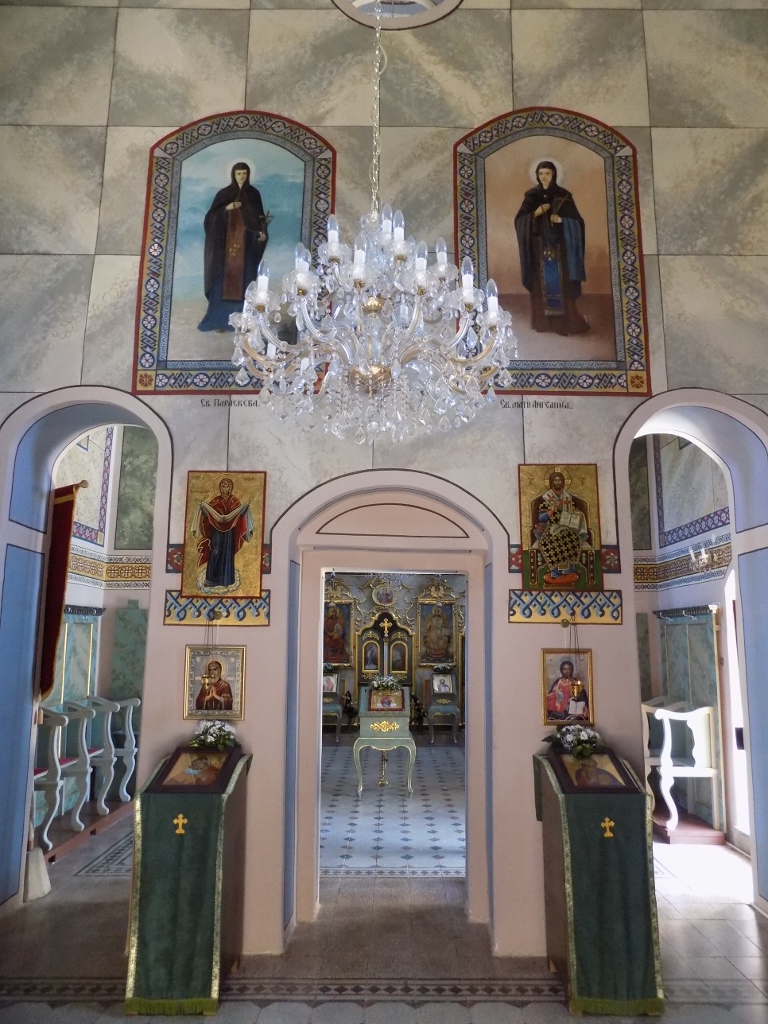 Narthex and the view toward the naos
Narthex and the view toward the naos
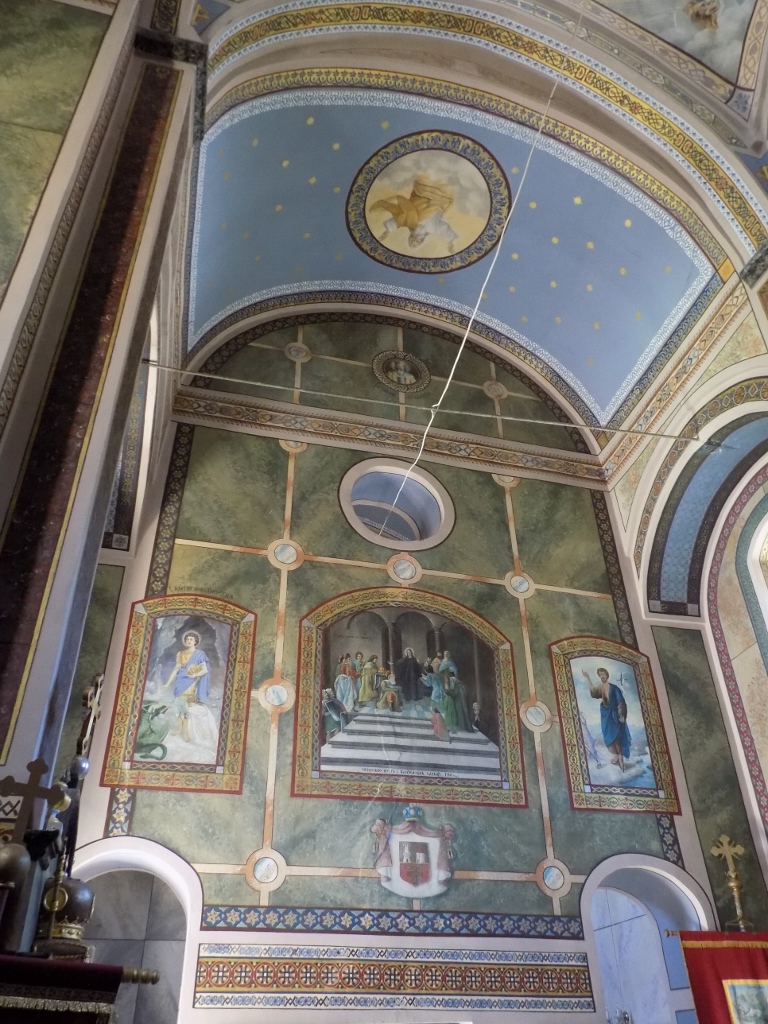 View at the wall separating the naos and the narthex, and at the vault
View at the wall separating the naos and the narthex, and at the vault
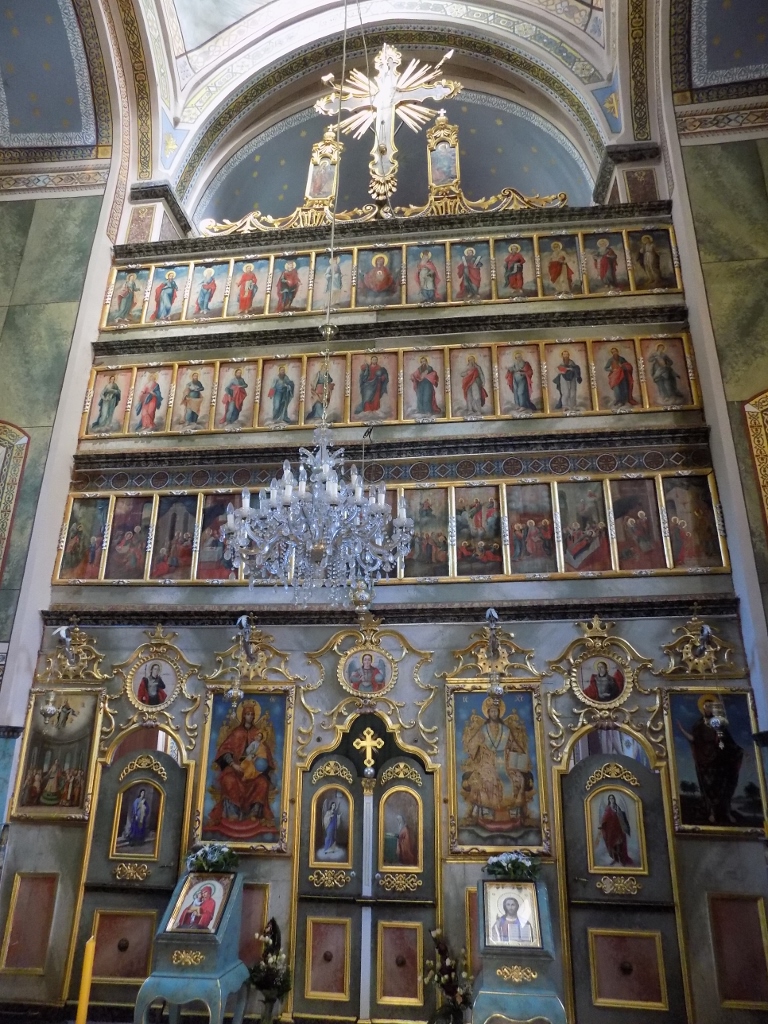 Iconostasis of the church in Mala Remeta Monastery
Iconostasis of the church in Mala Remeta Monastery
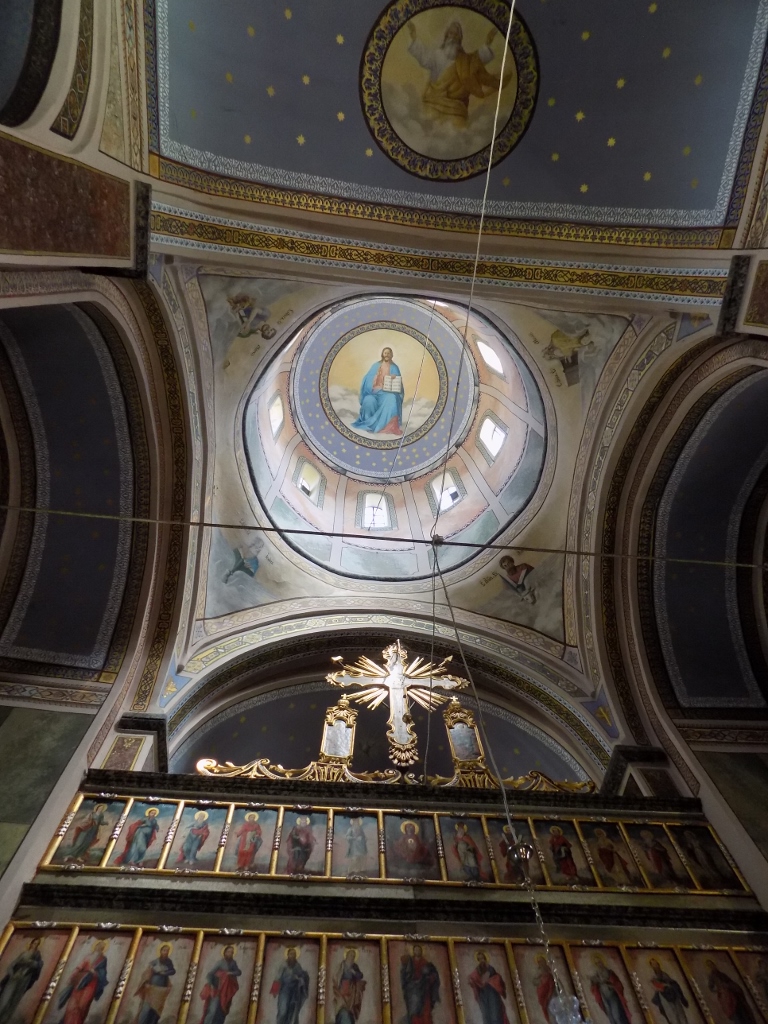 View at the interior of the dome
View at the interior of the dome
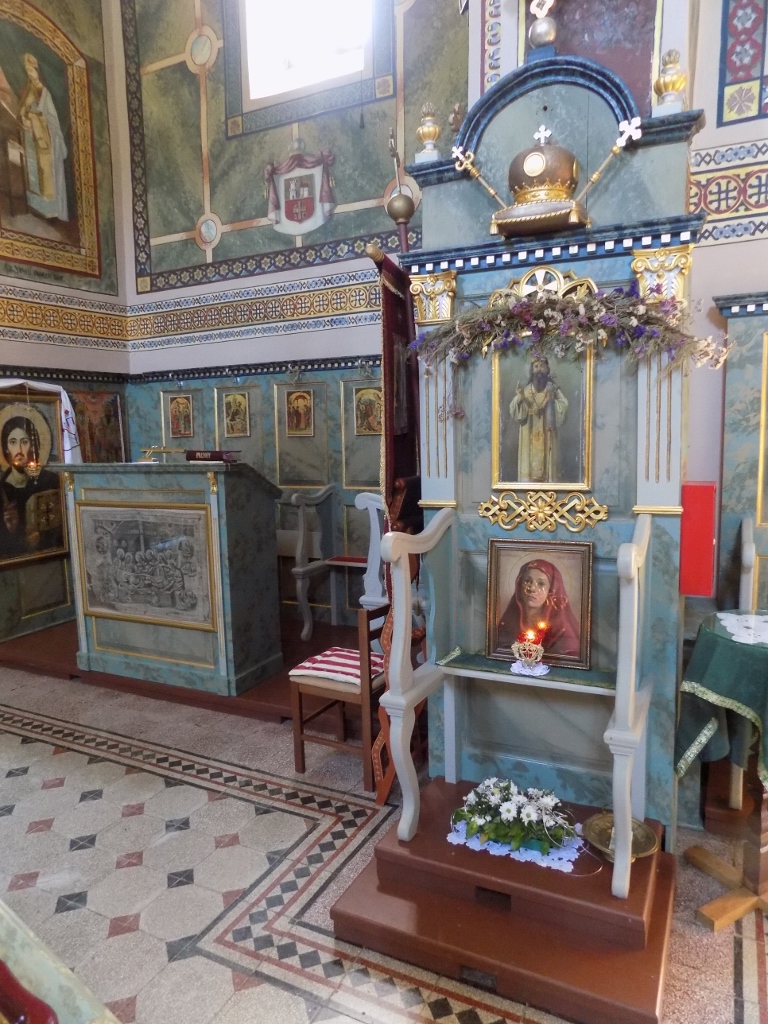 Details from the interior of the Church of the Intercession of the Holy Virgin in Mala Remeta Monastery
Details from the interior of the Church of the Intercession of the Holy Virgin in Mala Remeta Monastery
After the visit to the church, I also took a photo of the bell tower that exists within the churchyard and then we headed for the side exit from the monastery.
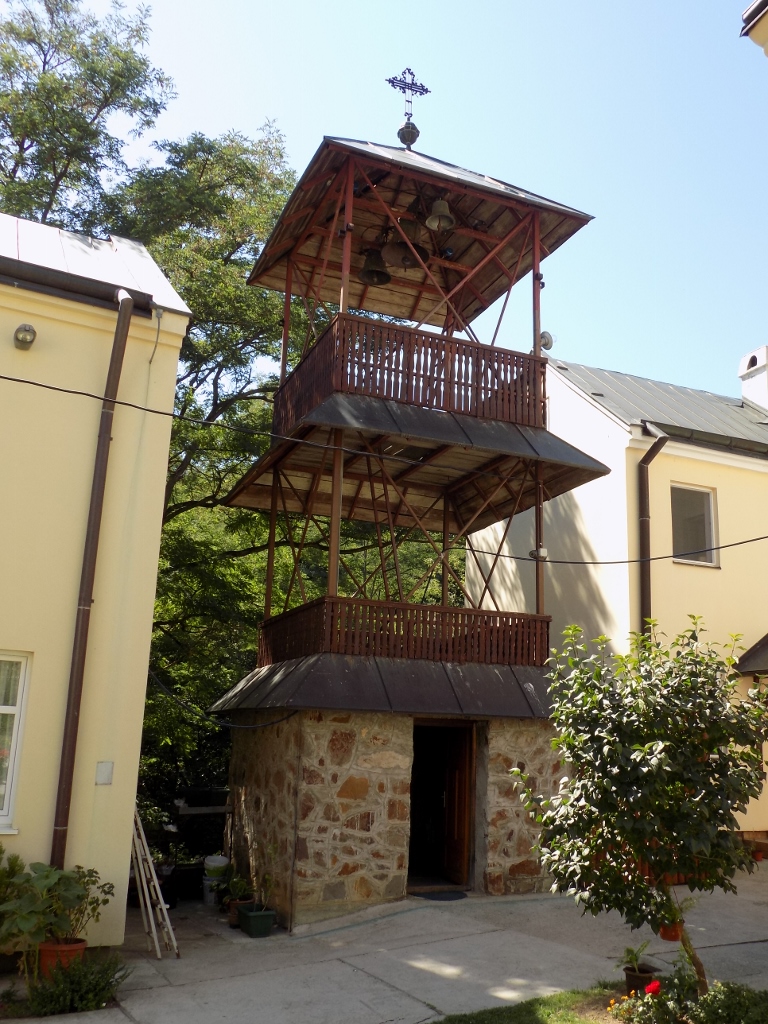 Bell tower in Mala Remeta Monastery
Bell tower in Mala Remeta Monastery
Before leaving the churchyard, I looked back once again admiring the beautiful church in Mala Remeta Monastery.
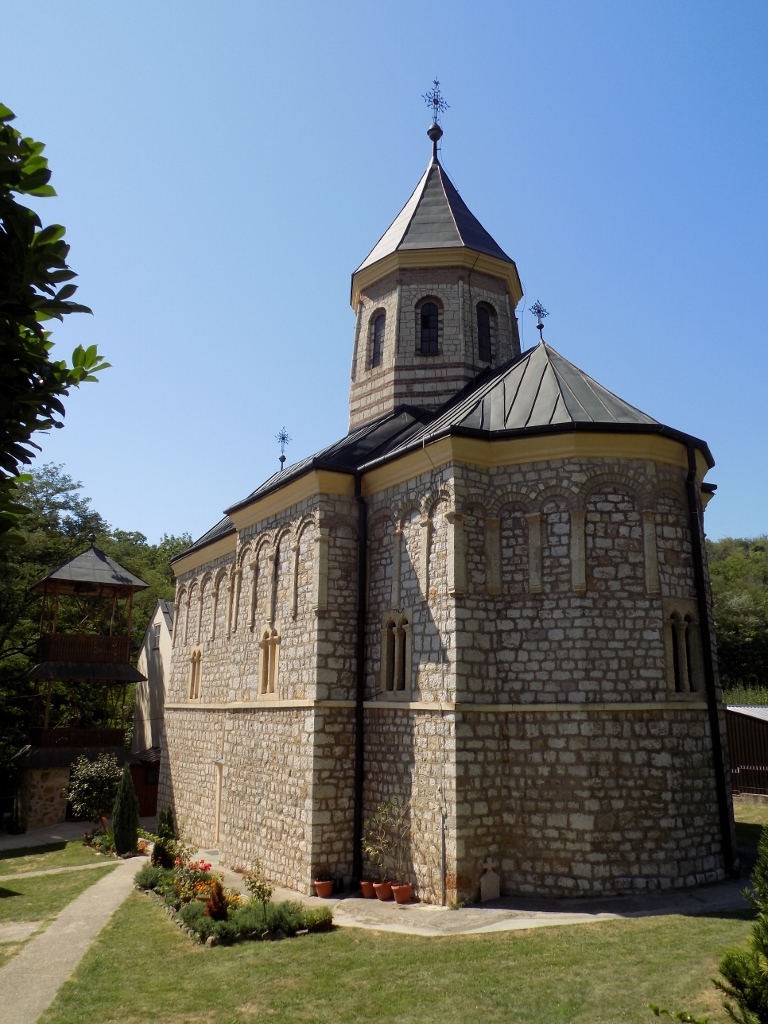 Church of the Intercession of the Holy Virgin in Mala Remeta Monastery
Church of the Intercession of the Holy Virgin in Mala Remeta Monastery
Practically, as soon as one leaves the monastery’s yard one reaches a crossroad and there, on a small elevation with trees, there is a memorial, again linked to WWII. Still, by this time the three of us were so exhausted from the heat and ready for a long break that any climbing anywhere was out of question, no matter how small the elevation was.
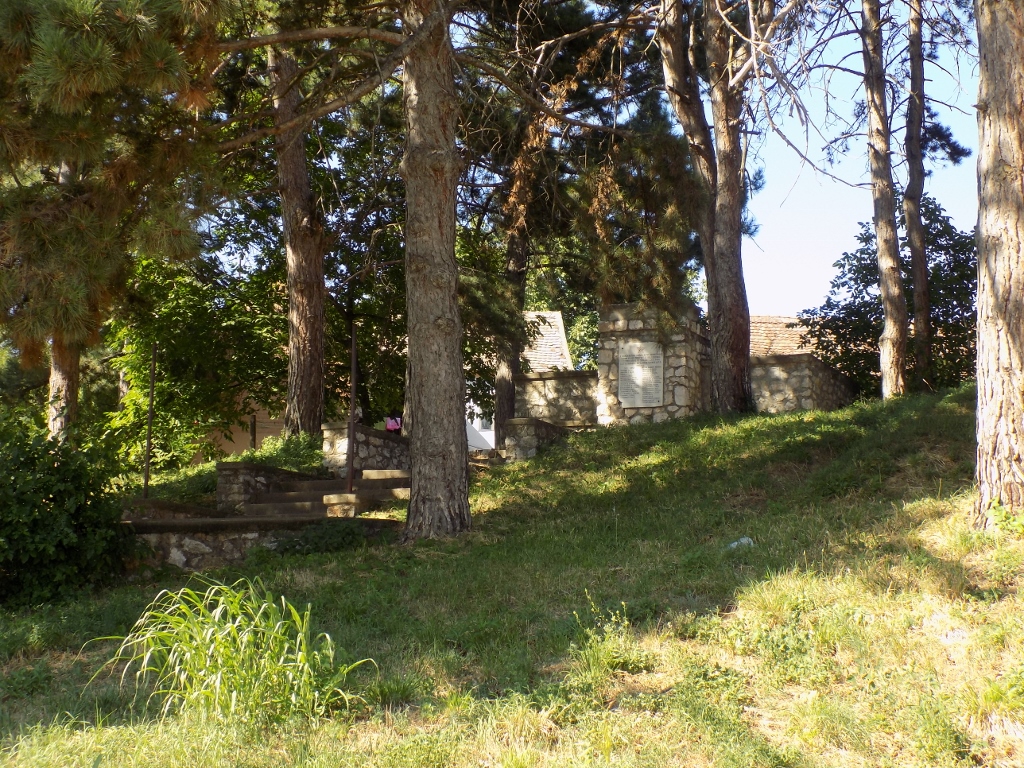 Elevation in Mala Remeta village with the monument linked to WWII
Elevation in Mala Remeta village with the monument linked to WWII
Instead, we went to a local restaurant that had been recommended to us and we decided to have lunch there. I personally opted for the local specialities and since there is a lot of game in the forests of Fruška gora, I ordered game stew – as I was told 75% deer and 25% wild boar. With no guilty conscience I can say that the whole meal was fantastically tasty, while the meat simply melted in my mouth.
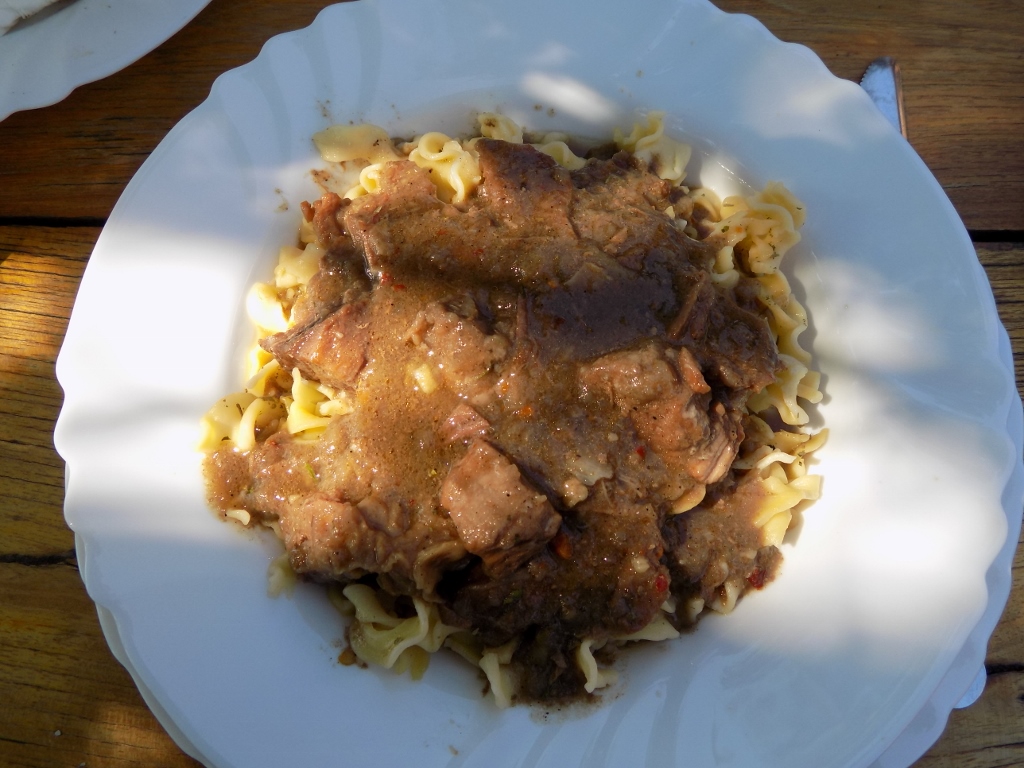 Game stew
Game stew
Needless to say, we also dealt with the issue of hydration of our exhausted bodies and when it was all done and we paid the bill, we got our things and headed along a shortcut towards Jazak village and the nearby monastery of the same name where the car was waiting for us.
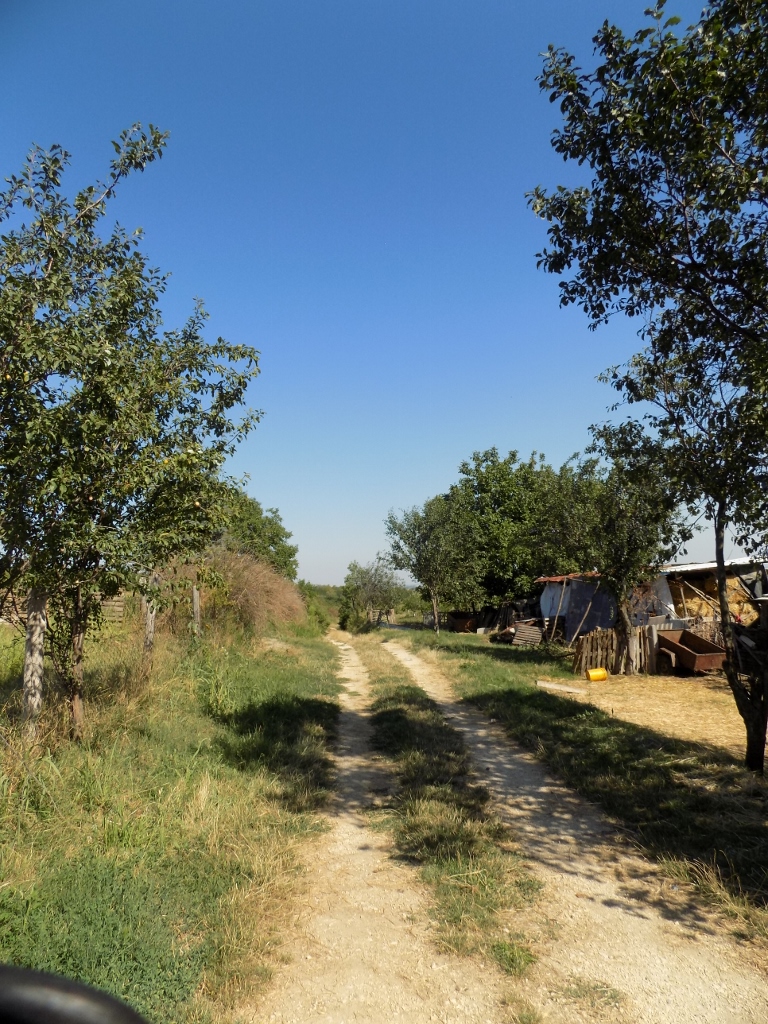 Dirt road leading to Jazak village
Dirt road leading to Jazak village
It was still very hot, but we knew we were close to the end now and thus we found the walking less strenuous. In addition, the sights around us were stunning, such as the numerous golden fields of harvested grains that we passed by.
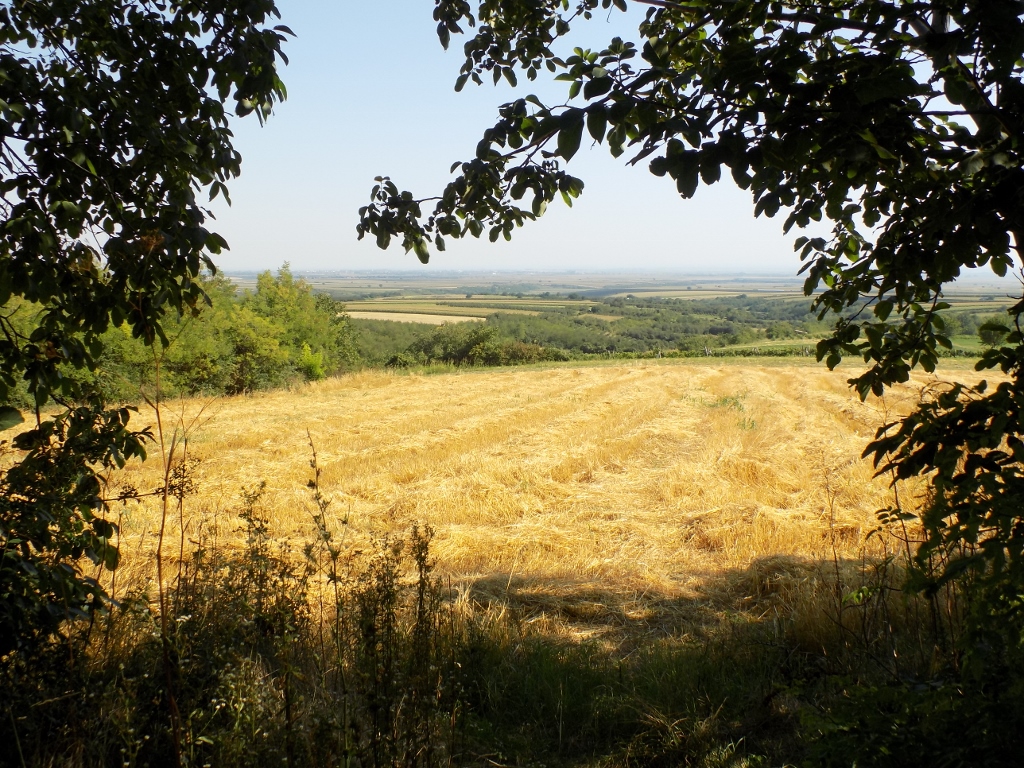 Harvested grains
Harvested grains
When we reached Jazak Monastery, I took a photo of it again, almost from the same spot as several hours earlier, but it was all lit quite differently now.
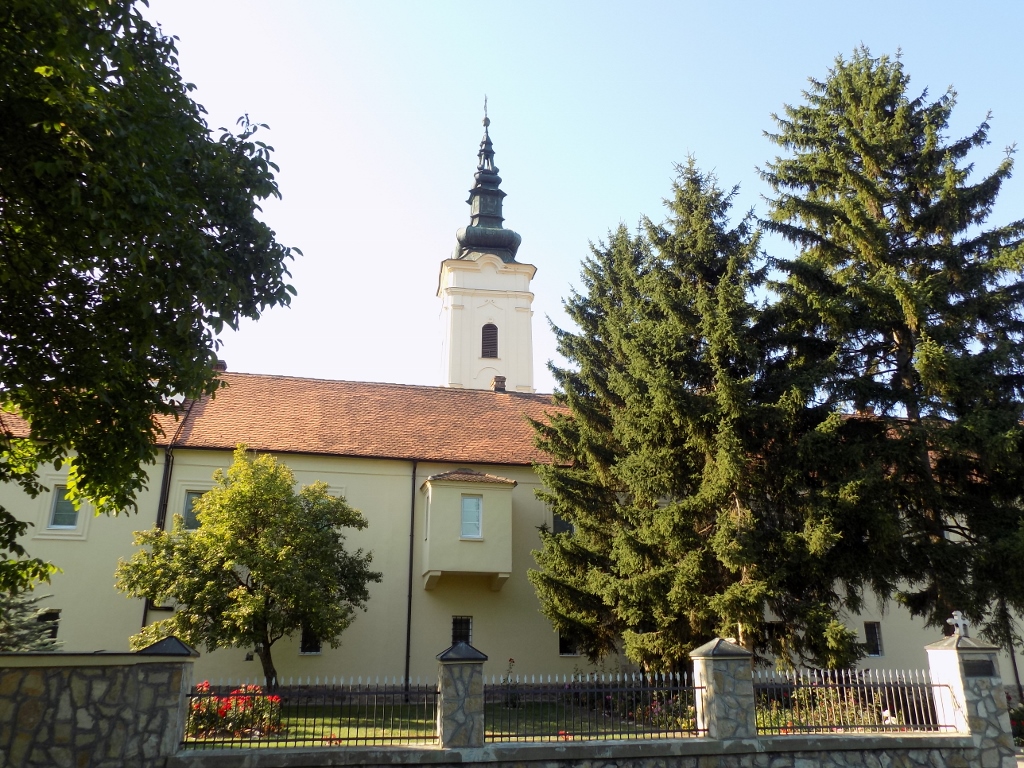 Jazak Monastery
Jazak Monastery
The car was still in the shade of a huge tree, so it was not too hot inside, but we still did not get in right away, waiting rather to cool down. Then we drove to Jazak village, as it was on our way, plus there is also another cultural monument, this time of great importance. It is the Church of St. Nicholas.
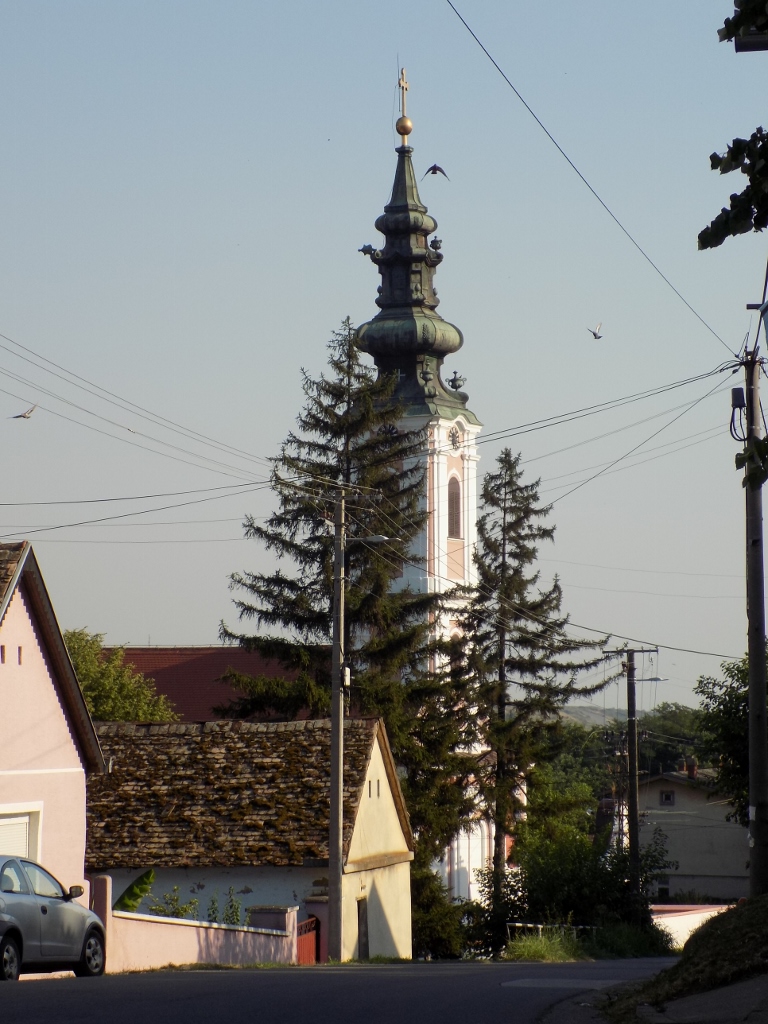 Church of St. Nicholas in Jazak village
Church of St. Nicholas in Jazak village
The church was built in the second half of the 18th century, while its iconostasis was made at the end of the 18th century and painted at the beginning of the 19th century. Inside, there are wall paintings from the second half of the 19th century, as well as a movable icon from 1785. Still, it was Sunday afternoon and I presumed the church would be closed, as it was indeed. Irrespective of that, we parked by the fence and made a brief circle around it.
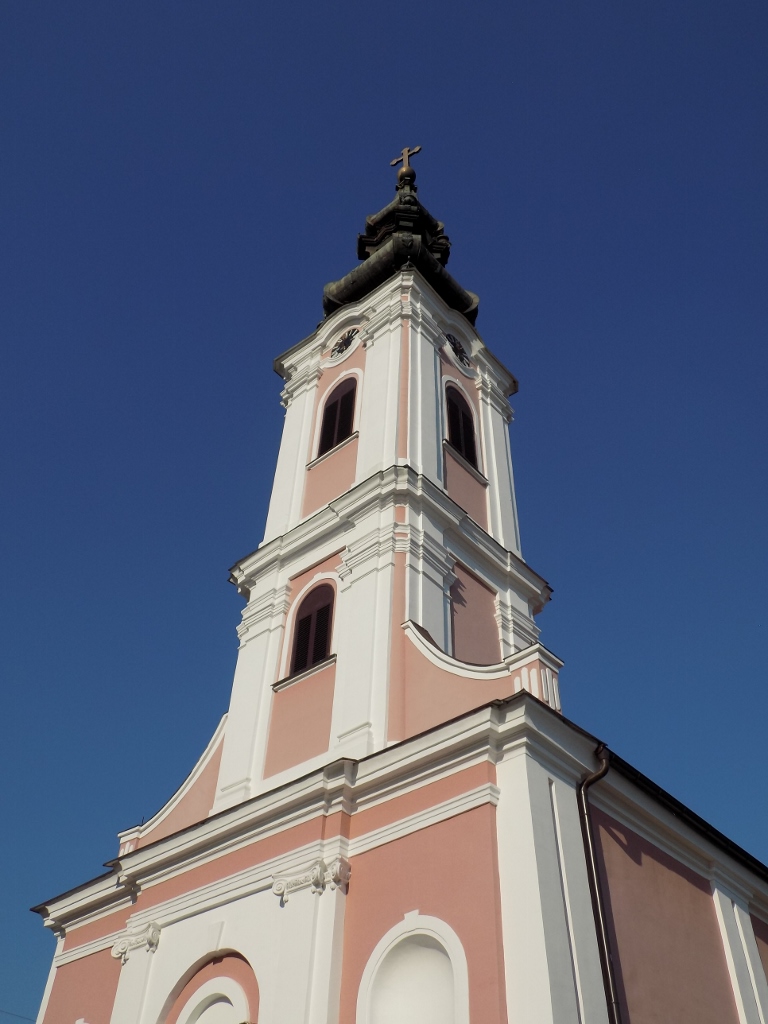 Bell tower of the Church of St. Nicholas in Jazak village
Bell tower of the Church of St. Nicholas in Jazak village
It was here that we completed our walks and sightseeing in Vrdnik and its surroundings. We only had to drive back to Belgrade and here is again the map of the road and the places that we visited.